
The Navy Department Library
the guidebook for NAVAL RESERVE CHAPLAINS
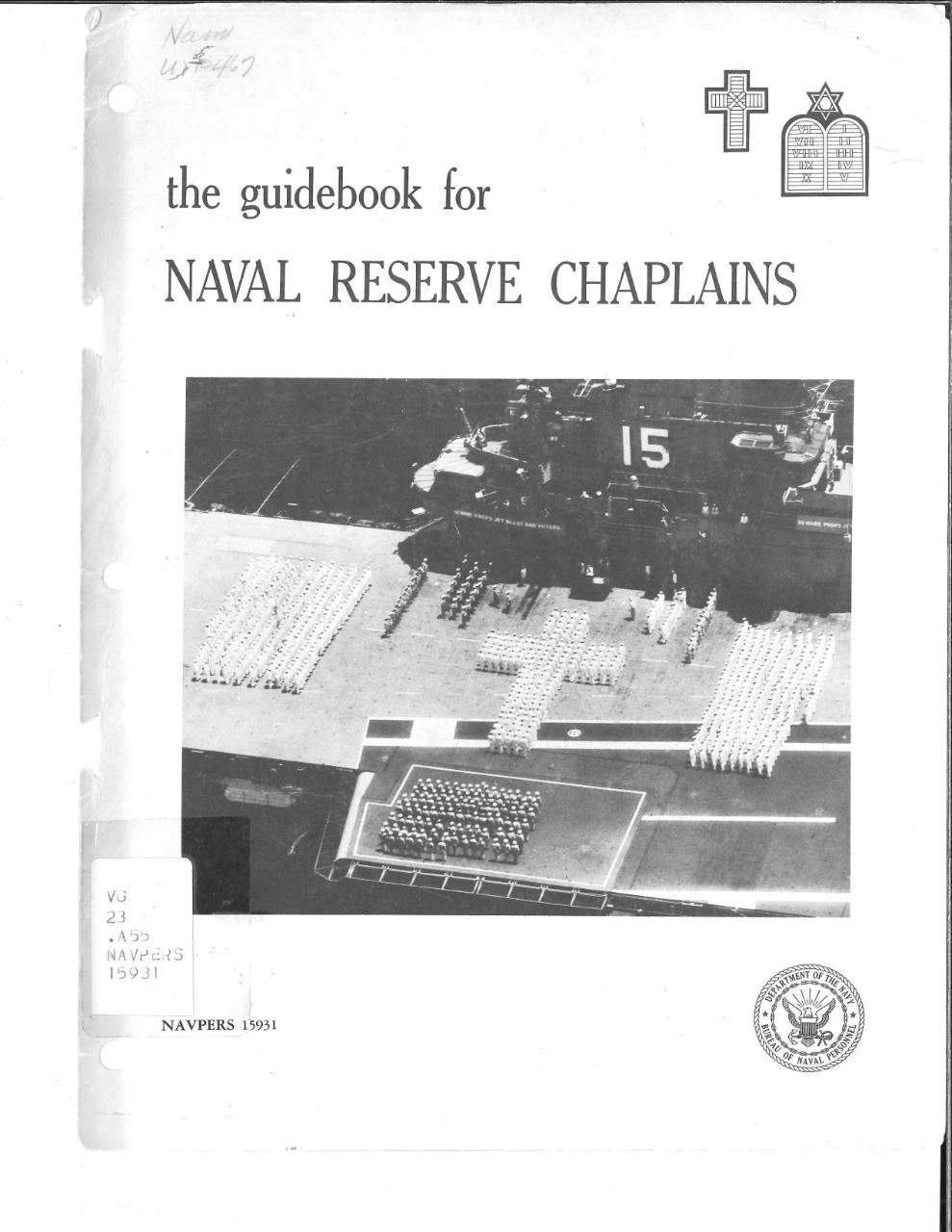
Upload PDF Version [13.9MB]
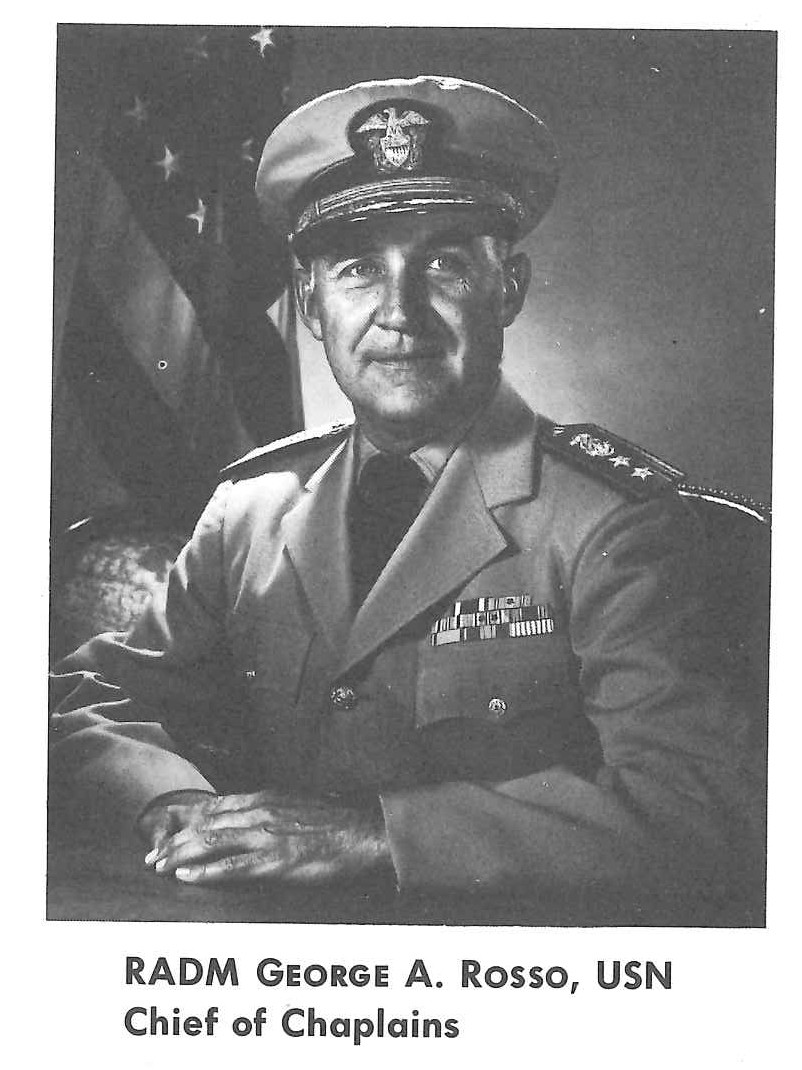
Foreword
THIS GUIDEBOOK FOR NAVAL RESERVE CHAPLAINS is especially prepared for use by chaplains on active and inactive duty. By the very nature of the situation, the work of the Naval Reserve Chaplain is a responsible one. He is charged with assisting the Commanding Office in the spiritual and moral conduct of the personnel. Just as he knows the canons or rules of discipline for his civilian ministry, he must be acquainted with the current directives of the Navy for his effectiveness on ship or station.
There are many aids available to him in carrying out his ministry and dusty. It is the purpose of this Guidebook to place quickly found information into the hands of the Reserve Chaplains.
I
Naval Reserve
TERMINOLOGY
and
DEFINITIONS
Active duty. Full-time duty with the active military service of the United States other than active duty for training.
Active duty for training. Full-time duty with the active military service of the United States for training purposes.
Active status. All Ready Reservists and those Standby Reservists who are not on the Inactive Status or Retired Lists are in active status.
Active status pool. Comprised of all personnel who are in an active status except those on active duty and those in a drilling unit in the Naval Reserve Program.
Allowance. The number of personnel by grade and designator or rating authorized to be attached to pay units of the Naval Reserve in drill pay billets.
Allowed quota. The number of personnel by grade and designator or rating authorized to be attached to pay units of the Naval Reserve.
Anniversary year. For Reservists who entered the Navy prior to 30 June 1949, the anniversary year will be from 1 July to 30 June, or the same as the fiscal year. For those members entering after 30 June 1949, or whose Reserve service was broken after that date, the anniversary year extends from the date of entry or re-entry, for the purpose of computing a satisfactory year.
Attached. Any Reservist who is assigned to a billet within an authorized unit allowance is “attached” to that unit.
Appropriate duty. That duty authorized to enable the Commandants to accomplish various special tasks in connection with the Naval Reserve Programs.
Appropriate duty pay pool. Those personnel issued orders authorizing the performance of periods of appropriate duty with pay.
Associate quota. This is the number of billets authorized for a unit in addition to its allowance, for training, administrative procurement support purposes.
Associated. Any Reservist who is assigned to a billet within an authorized unit associate quota is “associated” with that unit.
Designator code. The Designator code is a four-digit number used to group both billets and offices by categories for personnel accounting and administrative purposes and to identify the status of officers. A designator 4100 indicates Regular Navy Chaplain; 4105, Reserve Navy Chaplain; 4103, Regular Navy Chaplain, Retired; 4109, Reserve Navy Chaplain, Retired; and 1945 indicates Ensign Probationary, Chaplain Corps.
III
Duty. Military service of any nature under orders or authorization issued by competent authority.
Fiscal year. Government fiscal year begins on 1 July and ends on 30 June.
Inactive duty training. Any of the training, instruction duty, appropriate duties, or equivalent training, instruction, duty or hazardous duties performed with or without compensation by members of the Naval Reserve as is prescribed by the Secretary of the Navy; includes also the performance of special additional duties, as may be authorized by competent authority of such members on a voluntary basis in connection with the prescribed training or maintenance activities of the unit to which Reservists are assigned. Work or study performed by such Reservists in connection with approved correspondence courses shall be deemed inactive duty training for which compensation is not authorized.
Inactive Status List. Personnel of the Naval Reserve in an inactive status who has been placed thereon in accordance with the regulations prescribed by the Secretary of the Navy.
Partial Mobilization. This is the limited expansion of the active forces through the selective recall to active duty of individual Reservists and organized units. Normally, only Ready Reservists will be recalled in a partial mobilization.
Promotion point. This is a numerical unit awarded for the successful completion of a defined portion of an approved training program for the purpose of establishing eligibility for promotion.
Ready Reserve. This includes all Reservists who are liable for active duty either in time of war or national emergency, declared by Congress or the President of when otherwise authorized by law. Only Ready Reservists may receive pay for taking part in inactive duty training. The availability for active duty of Ready Reservists during mobilization is considered to be total. Requests for deferment of orders during mobilization will be approved under only the most extraordinary circumstances.
Reserve Component. The Naval Reserve is the reserve component of the Navy. The Marine Corps Reserve is the reserve component of the Marine Corps.
Retired Reserve. Reservists who are on the Retired Lists, according to regulations set up by the Secretary of the Navy, are liable to be ordered to active duty involuntarily only in time of war or national emergency declared by Congress.
Retirement point. This is a unit used to credit an individual for participation.
Selected Reserve. The Selected Reserve is the drill-pay portion of the Naval Reserve. Organized into appropriate units, trained for specific wartime tasks, and pre-ordered to specific mobilization billets, the selected reserve are pre-processed to provide personnel in operational readiness for immediate response to urgent need in the early stages of readiness for immediate response to urgent need in the early stages of hostilities.
Standby Reserve. These Reservists are liable for active duty only in time of war or national emergency declared by Congress or when otherwise authorized by law.
Standby Reserve-Active (USNR-S1). Standby Reserve-Active is composed of those officers who have completed their legally obliged period of membership in the Ready Reserve and who desire to retain an active status. In addition this group includes those who are physically unqualified for retention in the Ready Reserve.
Standby-Reserve-Inactive (USNR-S2). Standby Reserve-Inactive is composed of those officers who have completed their legally obligated period of service in the ready reserve and who are temporarily unable to participate actively in the Naval Reserve Program.
Supervisory Chaplain. Chaplains of major commands such as the Fleet, Force and District Chaplain. In commands where there are chaplains, the senior chaplain will be the Supervisory Chaplain. The Supervisory Chaplain for an activity wherein there is no chaplain will be the chaplain in the subordinate command to which the activity is subordinate.
Total Mobilization. This is the expansion of the active forces to full wartime strength through the general recall of all Naval Reservists. iv
TABLE OF CONTENTS
Preface i NAVAL RESRVE TERMINOLOGY AND DEFINITIONS Page
An alphabetical listing of definitions of terms for quick reference v
Preface ii REFERENCE GUIDE FOR THE NAVAL RESEVE CHAPLAINS’ PROGRAM
Official Directives XIII
Official Reference Manuals and Publications XVI
Note. The frequent references appearing in the marginal notes throughout this Guidebook are identified in these introductory pages.
Chapter 1. TYPES OF DUTY
Preliminary Information 1
Active Duty 1
Naval Reserve Chaplain Companies 2
The Support Program – Naval and Marine Corps Reserve Activities – Appropriate
Duty with/without pay 2
The Support Program – Active Duty for Training 4
The Support Program – Summer Cruises 4
Composite Companies 5
Commandant’s Local Representative 5
Appropriate Duty Without Pay Assignments 5
Chaplain Seminars 6
Denominational Retreats and Seminars 6
Symposia and Conventions 6
Selection Boards 6
Special Projects 6
Concluding Information 7
Chapter 2. THE CHAPLAINS’ SPIRITUAL MINISTRY
The Chaplain – A Religious Leader 9
Religious Services and Ministrations 9
Counseling 10
The Casualty Assistance Call Program 11
THE LAY LEADERSHIP PROGRAM
Preliminary Information 13
The Chaplains’ Responsibility in this Program 13
Limitations to Lay Leadership Functions 13
Ecclesiastical Equipment and Supplies 14
How to Assist the Lay Leaders 14
Lay Leadership-Protestant 14
Lay Leadership-Catholic 15
Lay Leadership-Jewish 16
V
Chapter 3. THE NAVAL LEADERSHIP PROGRAM Page
Protection of Moral Standards 19
The Character Education Program 20
Moral Leadership 20
The Chaplain – A Key Officer in the Leadership Program 20
Available Materials for Implementing the Naval Leadership Program 20
Suggested Program for Chaplains Serving With Reserve Activities 21
SUBJECT: LEADERSHIP
The Objective of General Order Number 21 22
Naval Leadership and Character Education 22
Leadership Standards 22
Steps Taken by the Chief of Naval Personnel to Emphasize Leadership 22
The Standing Committee on Leadership 23
Leadership Field Teams 23
Publications Pertinent to the Naval Leadership Program 23
THE CHAPLAIN AND NAVAL LEADERSHIP
Effective Naval Leadership 24
Principles and Problems of Naval Leadership 24
The Moral and Spiritual Growth of Naval Personnel 24
Chapter 4. TRAINING
Preliminary Information 27
Training For the Newly Appointed Chaplain 27
Training For the Veteran Reserve Chaplain 27
Naval Reserve Chaplain Companies 27
The Five-Year Curriculum for Chaplain Companies 27
Training for Ensigns Probationary 28
Qualifications for Commission as Ensign Probationary 28
Introductory Training at the Chaplain School 28
The Chaplain School-Eligibility Requirements for Training 29
The Chaplain School Curriculum 29
Correspondence Courses-Establishing Professional Fitness 29
Promotion and Retirement Points 29
Courses Prescribed for Chaplains 29
Computing of Points for Correspondence Courses 29
A Table of Correspondence Courses Prescribed for Reserve Chaplains Not on
Active Duty 30
Naval Reserve Officers School (NROS) 31
Active Duty For Training-Diverse Types 31
Uniform Regulations and Reimbursement 31
Initial Uniform Allowance 31
Additional Active Duty Uniform Allowance 31
Uniform Maintenance Allowance 31 VI
Chapter 4. TRAINING-Continued Page
Wearing of Decorations, Medals and Awards 32
Informal Naval Reserve Training 32
Responsibility for Keeping Informed on Naval Reserve Matters 32
Publications Containing Pertinent Naval Reserve Information 32
District Chaplains’ Newsletters 32
Chapter 5. ECCLESIASTICAL RELATIONS AND RESPONSIBILITIES
Preliminary Information 35
The Reserve Chaplain and the Endorsing Agency 35
The Endorsing Agency and the Chaplains Division 35
The Reserve Chaplain in the Local Community 35
The Support Program-The Appropriate Duty Chaplain 36
Multiple Drills 36
Reserve Chaplain Companies and Ecclesiastical Relations 36
Concluding Suggestions 36
Chapter 6. PUBLIC RELATIONS-RESPONSIBILITIES AND OPPORTUNTIES
Preliminary Information 39
Developing Public Relations Sense 39
The Reserve Program and Public Relations 39
The Biographical Sketch 39
Chaplains in the News 39
Chaplains’ Public Addresses 39
Keeping the Chief of Chaplains Informed 40
Suggestions for Fruitful Public Relations 40
The Support Program and Public Relations 40
Liaison With the Public Relations Officer 40
Mass Media Activities-Press, Radio, Television 40
The Chaplain Companies and Public Relations 41
A Reserve Chaplain as Public Information Officer in the Chaplain Company
Membership 41
Concluding Suggestions 41
Chapter 7. PROMOTION AND RETIREMENT
Promotion Eligibility 43
Promotion Zones and Promotion Points 43
Promotion By Selection-The Selection Board 43
The Fitness Report 43
Failing Selection For Promotion 43
Professional Requirements for Promotion 43
Promotion Points for Each Year In Grade 44
Various Methods for Accruing Promotion Points 44
Minimum Promotion Points Required Annually 44
Correspondence Courses 45
VII
Chapter 7. PROMOTION AND RETIREMENT-Continued Page
Naval Reserve Officers Schools Courses (NROS) 45
Promotion Point Credits for College Courses and Residency Training 45
Retirement Eligibility 45
Twenty Years Satisfactory Federal Service 45
Satisfactory Years Prior to Age 60 45
Satisfactory Years Subsequent to Age 60 45
Military Service Non-Creditable 45
The Inactive Status List 46
Retirement Points Creditable 46
Satisfactory Year and Anniversary Year Defined 46
Gratuitous Points 46
Methods for Accruing Retirement Points 46
Appropriate Duty Points Creditable 46
Maximum Appropriate Duty Points Per Annum 46
Maximum Points Creditable Per Annum for all Inactive Duty Training 46
Alternative Actions Upon Completion of Twenty Years Satisfactory Service 47
How to Determine Retirement Pay 47
An Annuity For Your Family-The Uniformed Services Contingency Option Act of
1953 for Naval Reservists 47
Privileges of Reservists Retired With Pay 48
The Reserve Officers’ Recording Activity (RORA) 48
NAVAL RESERVISTS’ PAY CHART-HOW TO DETERMINE THE APPROXIMATE AMOUNT
OF RETIREMENT PAY 49
Chapter 8. PROTOCOL AND REPORTS
Preliminary Information 51
Correspondence and Official Forms 51
Submission of Reports 51
Frequency of Required Fitness Reports 52
The Opportunity to Consult Fitness Reports 52
Annual Qualifications Questionnaire 52
National Agency Check-Periodic Security Clearance 52
Medical Questionnaire-Determining Physical Fitness 53
Change of Address-Actual Mailing Address Defined 53
Travel and Residence Abroad-Foreign Travel Regulations 53
Reports Required by the District Chaplain 53
The Chaplains Division-Assistance in Naval Reserve Matters 54
The District Chaplain’s Responsibility in the Naval Reserve Program 54
Sample Fitness Report and Work Sheet-Report On The Fitness of Officers
(NavPers 310) 55
Sample Fitness Report and Work Sheet-Report On The Fitness of Naval Reserve Officers
On Inactive Duty Participating in Drilling Programs or under Appropriate Duty Orders
(NavPers 937) 58
VIII
Appendix THE NAVAL RESERVE CATEGORIES Page
Ready Reserve 60
Standby Reserve-Active 60
Standby Reserve-Inactive (The Inactive Status List) 60
Retired Reserve 60
Requirements for Transfer to the Retired Reserve 61
Transfer to the Ready Reserve From Other Categories 61
The Ready Reserve Agreement 61
Submission of a Ready Reserve Agreement for Further Retention Upon Expiration
Of Current Agreement 61
Statutory Obligation for Retention in the Ready Reserve 61
IX
Reference Guide
pertinent to the
Naval Reserve Chaplains’ Program
1. OFFICIAL DIRECTIVES
NOTE:
For the purpose of this Guidebook, the basic number of each Bureau of Naval Personnel Instruction is given, which will suffice the Reserve Chaplain in determining the numerical series of the subject concerned.
Reference
(a) BuPers Instruction 1331.4
Voluntary Extended Active Duty For Reserve Officers
(b) BuPers Instruction 1120.12
The Regular Navy Augmentation Program
(c) BuPers Instruction 1743.1
Chaplain Corps Program of the Naval Reserve
-(See also BuPers Instruction 5400.1)
(d) BuPers Instruction 5400.1
Tables of Organization For The Naval Reserve
-Chaplains’ Appropriate Duty Billets With or Without Pay
-Multiple Drills at Reserve Training Centers
-Equivalent Duty
-Selective Service Program-Participation with Drilling Units
-Chaplains as Commandant’s Local Representative
-Chaplains’ Attendance at Applicable Symposia and Conventions
-The Chaplain Company-Designated as a Specialist Program of the Naval Reserve
-Chaplain Companies-Pay Status for Commanding Officers and Staff Members
(e) BuPers Instruction 1571.1
-Two weeks Active Duty For Training With or Without Pay
-Cruises in Fleet and Naval Reserve Ships
-Active Duty For Training in the Navy Department
-Active Duty for Training for Extended Periods in excess of fourteen days but not more than ninety days
-Point Credits for Active Duty for Training
-Transportation and Subsistence in Connection with Travel
-Active Duty For Training for Reservists residing Outside the Continental United States
(f) BuPers Instruction 157.4
-Priority System of Frequency For Active Duty For Training, by Ranks, for Officers in a Non-Pay Status XI
Reference
-Security Clearance Requirements
-Chaplains Seminars Convened Annually For Training in Chaplains’ Duties; Four-
Teen Days Duration; Quotas; Schedules
(g) BuPers Instruction 3500.8
Composite Program of the Naval Reserve
(h) BuPers Instruction 1580.2
Cross-Service Reserve Training
(i) BuPers Instruction 1520.11
Selective Service Program of the Naval Reserve
(j) BuPers Instruction 1300.3
Pay Units of the Naval Reserve-Assignment and Termination Policies and Procedures
(k) BuPers Instruction 1001.5
Organization of the Naval Reserve under the Armed Forces Reserve Act of 1952, as amended
-Definitions and Terms Commonly used throughout the Naval Reserve Program
-Categories and Status if Reservists
-The Training Categories for the Naval Reserve
(l) BuPers Instruction 1820.1
Nondisability Retirement With Pay For Members of the Naval Reserve
-Voluntary Retirement of Officers after 20 years’ Active Service
-Voluntary Retirement after 30 or 20 years’ Active Service as a Member of the Armed Forces
-Voluntary Retirement of Members of the Naval Reserve Upon Reaching Age 60, and After Completion of 20 years’ Satisfactory Federal Service
-Privileges of Naval Reserve Personnel Retired With Pay
-Obligations of Retired Personnel
-Retirement Points Creditable
-Gratuitous Points
-Satisfactory Year and Anniversary Year Defined
-The Reserve Officer Recording Activity (RORA)
-Retirement Points Creditable
-Gratuitous Points
-Satisfactory Year and Anniversary Year Defined
-The Reserve Officer Recording Activity (RORA)
-Retirement Pay Computations
-The Four Possible Actions after Completing 20 years’ Satisfactory Federal Service
(m) BuPers Instruction 1820.2
Transfer to the Retired Reserve Without Pay-Information Concerning
-Requirements for Transfer to the Retired Reserve; Years Completed; Age; Result of Service-Connected Disability
(n) BuPers Instruction 1821.1
The Categories of the Naval Reserve; Priorities For Recall
-The Ready Reserve (USNR-R)
-Ready Reserve Agreements-Procedures Concerning the Administration of -Length of Ready Reserve Agreements and Superseding Agreements; Binding Nature of Ready Reserve Agreements
-Ready Reserve Obligation; Statutory Obligation
-The Standby Reserve-Active (USNR-S1)
-The Standby Reserve-Inactive (USNR-S2) (Inactive Status List)
-The Retired Reserve (USNR-RET)
-Regulations and Procedures Governing the Assignment To, Transfer Between, and Discharge From the Reserve Categories
XII
Reference
(o) BuPers Instruction 1120.6
Naval Reserve Status of Personnel Possessing Critical Skills or Civilian Qualifications Incompatible Therewith-Policies Governing
(p) BuPers Instruction 1820.3
Retirement Credit for the Satisfactory Completion of Correspondence Courses
(q) BuPers Instruction 1412.1
Promotion of Naval Reserve Officers to Grades Above Lieutenant Junior Grade pursuant to the Reserve Officer Personnel Act of 1954
-Promotion by Selection; Eligibility for Consideration by Selection Boards; Duties of Selection Boards
-Professional Qualifications for Promotion to LT, LCDR, CDR, CAPT.
-Physical Qualification for Promotion
-Action Required by Individual Selectees
-Failing Selection for Promotion-Information Concerning
(r) BuPers Instruction 1416.4
-Professional Fitness For Promotion of Naval Reserve Officers Not on Active Duty
-Promotion Point Credits for Correspondence Courses and NROS Courses
-Promotion Point Credits for Extended Active Duty
-Promotion Point Credits for Active Duty For Training and Drill Participation
-Promotion Point Credits for College Courses and Residency Training
-Tables of Correspondence Courses Prescribed for Chaplains of the Naval Reserve
Not On Active Duty
(s) BuPers Instruction 1530.33
The Naval Reserve Officers Schools (NROS) Program
-Scope of Instruction for Officers of all Grades and Designators
-Eligibility for Student Enrollment and Procedures
-Authorized Drills and Equivalent Drills
-List of Courses Available
-Retirement and Promotion Points
-Non-Credit Participation
-Completion Certificates
(t) BuPers Instruction 1750.2
The Uniformed Services Contingency Option Act of 1953 for Naval Reserve Personnel
Not on Active Duty
-Summary of Principal Provisions of the Act
-Retired Pay to which the Act Applies
-Annuities which may be Elected
-Time Limit for making Election
-Limitation and Definition of Eligible Dependents
-Table of Examples of Benefit Payments
XIII
2. Official Reference Manuals and Publications
NOTE:
For the purpose of this Guidebook, the basic number of each official manual is given, which will suffice the Reserve Chaplain in determining the numerical series of the manual concerned.
Reference NavPers
(M-1) The Naval Reservist 15653
The Monthly Periodical of News of Interest to the Naval Reservist
(M-2) U.S. Navy Regulations 10740
-The Marine Corps
-The Welfare of Personnel
-Issuance of Personal Necessities to Personnel
-Observance of Sunday; Divine Services; Church Parties
-The American National Red Cross
-Marriages On Board
-The Duties of Chaplains Relating to Religious Activities of the Command
-Religious Customs and Institutions in Foreign Countries
-Treatment and Hospitalization of Personnel
-Manner of Addressing Officers; Chaplains
-Administration of Discipline
(M-3) Bureau of Naval Personnel Manual 15791
-Chaplains and Religion
-Chaplains’ Qualifications for Original Appointment in the Naval Reserve
-Current and Actual Mailing Address Defined
-Fitness Reports
-Officers’ Annual Qualifications Questionnaire
-Physical Examinations
-Travel and Residence Abroad
-Uniform Allowances and Claim Procedures
-Social Security Numbers Required on Orders for Active Duty for Training
(M-4) Chaplain’s Manual 15664
Official Information and References Pertinent to all Aspects of the Navy Chaplaincy
-The Naval Reserve Chaplains; Naval Reserve Program
-The Support Program of the Naval Reserve
-Service With the Marine Corps and at Naval and Marine Corps Reserve Activities
-The Moral Leadership and Character Education Program
-Selection of Candidates
-The Lay Leadership Program
(M-5) Navy Chaplains Bulletin 15020
Published Quarterly by the Chaplains Division, Bureau of Naval Personnel, as a source of Information and Inspiration to all Navy Chaplains
XIV
Reference NavPers
(M-6) Curriculum For Naval Reserve Chaplain Companies 92596
A Five-Year Course of Study Designed to Improve the Professional Fitness of Naval Reserve Chaplains
-Naval History; Naval Orientation
-History and Organization of the Chaplain Corps
-Chaplains’ Duties; Ecclesiastical Relations; Public Relations
-The Character Education and Leadership Program
-Master Bibliography of Publications applicable to the Chaplains’ Mission and Listings of Training Aids
(M-7) Manual For Casualty Assistance Calls Program (CACP) 15879
-Personal Calls to Next of Kin
-Assistance and Attendance at Funerals and Memorial Services
-Condolence Letters to Next of Kin
-The Decedent Affairs Program
-Emergency Need for Assistance with Personal Problems-The Navy Relief Society; The American National Red Cross
-Settling of the Deceased’s Estate
-Death Gratuity; Survivors’ Benefits and Insurance
-Flags; Headstones
-Official List of National Cemeteries
(M-8) Decedent Affairs Manual (BuMed Instruction 5360.1)
-Relationship Between Casualty Assistance Calls Program and the Decedent Affairs Program
-Responsibility for Notification under the Decedent Affairs Program-Death Outside the United States; Death Within the United States
-Methods of Notification-Condolence Letter Requirements; Forms of Telegraph Notification
-Transportation of Remains; Escorts’ Duties
(M-9) U.S. Navy Uniform Regulations 15665
-General Uniform Regulations
-Chaplains’ Wearing of Church Vestments with the Uniform
-Wearing of Church Vestments by other Personnel participating in Church Services
-Funerals-Special Uniform Regulations Regarding
-Minimum Uniform Requirements for Naval Reserve Personnel
-Wearing of Uniforms by Personnel Not on Active Duty
-After Discharge-Regulations and Laws pertaining to the Wearing of the Uniform
(M-10) The Navy’s Selected Reserve 15920
Questions and Answers on this Subject
(M-11) All Hands 0
The Bureau of Naval Personnel Information Bulletin (issued monthly)
(M-12) Officer Fact Book 15898
Navy Facts-A Guide to Assist in the Counseling of Regular and Reserve Officers
(M-13) Navy and Marine Corps Awards Manual 15790
-Information Pertaining to Decorations, Medals and Awards
-The Naval Reserve Medal
-Chart in Full Colors showing Ribbons of Decorations and Awards
XV
Reference NavPers
(M-14) Publications Pertinent to the Naval Leadership Program
-General Order Number 21-Subject: Leadership
-Protection of Moral Standards (BuPers Instruction 1743.2)
-Naval Leadership (BuPers Instruction 1000.14)
-Moral Leadership 15890
-Our Moral and Spiritual Growth-Here and Now 91962
-Because Of You 15874
-This Is My Life 15884
-For Better, For Worse 15904
-Effective Naval Leadership-A Message to Commanding Officers from the 15913
Chief of Naval Personnel
-Effective Naval Leadership and the Code of Conduct 15922
-Effective Division Officer Leadership 15914
-Leadership Discussion Guides-Officer 15915
-Leadership Discussion Guides-Enlisted 15916
-Department Head/Division Officer Leadership Check List 15918
-Chief Petty Officer/Petty Officer Check List 15919
-Principles and Problems of Naval Leadership-In Preparation: 15924
-For Men Only (NavPers Number not yet assigned)
-Getting to Know You (NavPers Number not yet assigned)
-The Man Within (NavPers Number not yet assigned)
(M-15) U.S. Navy Film Catalog 10000
Includes Listings of Training Films pertinent to the Chaplains’ Mission
-The Chaplain at Work and Chaplain Procurement
-The Chaplains’ Religious Education Program
-The Character Education Program
-Leadership and Proper Conduct
-Marriage and Family Life
-Military Justice
-The People To People Program
(M-16) Chaplains’ Film Service Manual
Provided Annually by the Chaplains Division, Bureau of Naval Personnel
-Listings of Religious Films and Related Subjects available on a rotation basis through District Chaplains
(M-17) U.S. Navy Public Information Manual (NavExos P-1035)
-Techniques of Utilizing Mass Media-Television, Radio, the Press
-Informing the Public; Community Relations
-Speeches and Speakers; Exhibits
-Preparation of Material for News Releases
-Chaplains’ Liaison with Public Information Officers
-Navy-Interest Groups; Navy Mothers’ Clubs; Schools; Youth Organizations -Navy Home Town News Program; News Stories; Photographs; Tape and Disc Recordings for Radio & Television
-Guest Cruises
(M-18) Lay Leaders Manuals (For the Training and Guidance of Lay Leaders)
-Lay Leaders Manual-Cruiser-Destroyer Force Pacific Fleet (ComCruDesPac Instruction 1743.3)
-“In Every Place”-Lay Leader Guide-Destroyer Force Atlantic (ComDesLant Instruction 1743.1)
-Armed Forces Hymnal (Scripture Selections & Lectionary)
XVI
Reference NavPers
(M-19) Navy Guide For Retired and Fleet Reserve Personnel 15891
Ready References For Retired Personnel Regarding Rights, Benefits and Privileges to which Entitled, including Dependents
-Naval Reserve Retired List
-Temporary Disability Retirement
-Procedure and Method of Payment; Taxable Income; Allotments
-The Uniformed Services Contingency Option Act of 1953
-Change of Address; Identification Cards; Wearing of the Uniform; Military Title
-Event of Death
(M-20) Rights and Benefits of Navymen and their Dependents 15885
General Information on this Subject
(M-21) Manual For Courts-Martial, United States, 1951
Naval Supplement to Manual For Courts-Martial, U.S. 1951
The Brig Manual 15825
(M-22) “No Greater Service”-Chaplaincy Procurement Pamphlet
-General Chaplaincy Information
-The Chaplain School; Training; Sub-Units of Instructions
-Chaplains’ Duty Assignment Rotation
-Ecclesiastical Equipment and Supplies
-Moral Leadership and Character Education
-The Chaplain As A Counselor
-Table of Monthly Base Pay; Quarters Allowance
-The Reserve Chaplains; Qualifications For Appointment
-The Ensign Probationary Program; Qualifications For Appointment
-Post Graduate Studies For Chaplains
-Listing of Offices of Naval Officer Procurement throughout the United States
(M-23) Marine Corps Manual
Official Reference For Reserve Chaplains Serving with Naval and Marine Corps Reserve Activities
(M-24) Casualty Assistance Calls Standing Operating Procedures
The Casualty Assistance Calls Program in the U.S. Marine Corps
XVII
Chapter One
TYPES OF DUTY AND ACTIVE DUTY FOR TRAINING
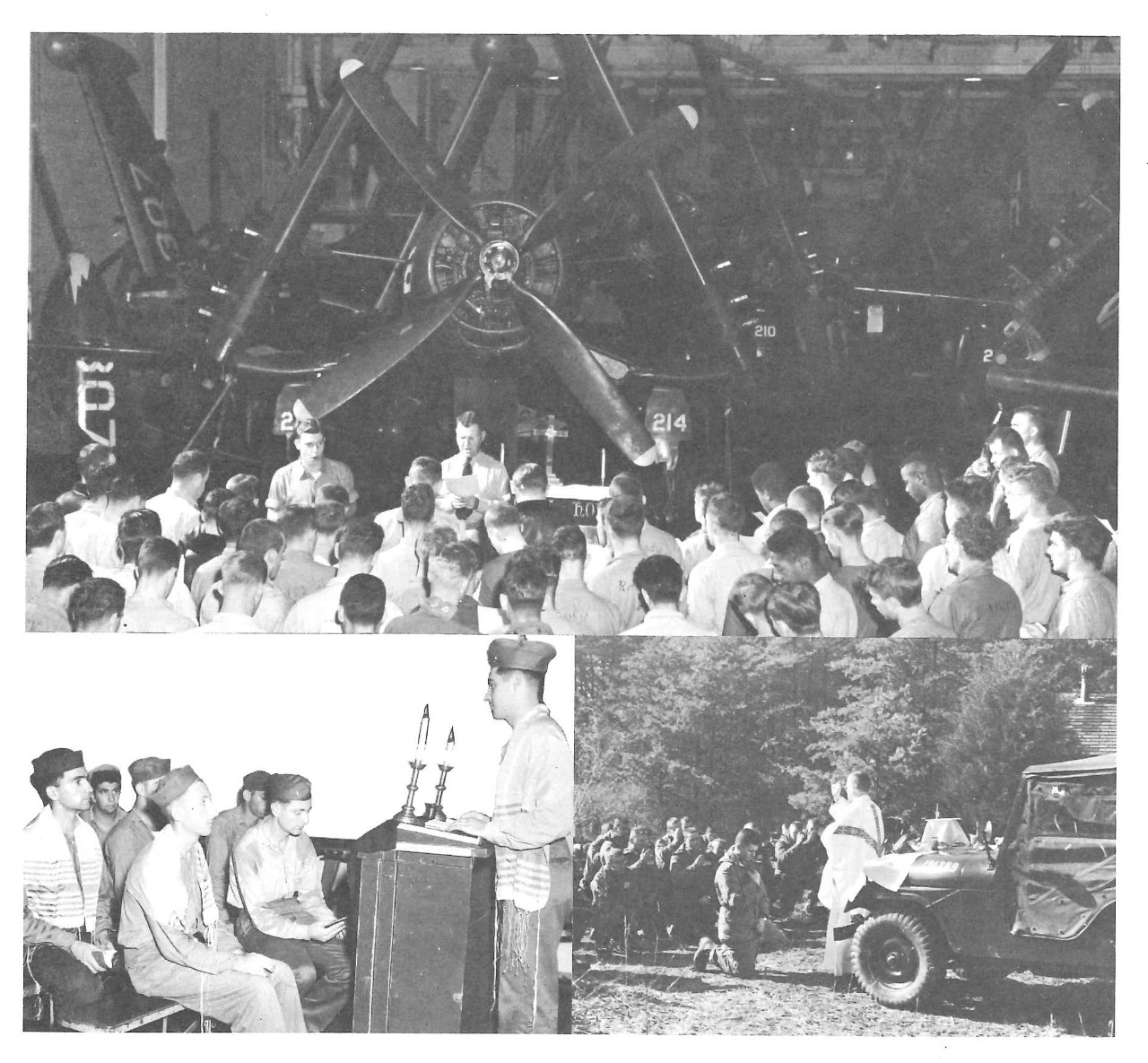
Chapter One
SERVICE TO GOD AND COUNTRY IN RELATION TO TYPES OF DUTY
1. Preliminary Information
THE NAVAL RESERVE PROGRAM offers broad opportunities to its chaplain reservists for service, for training, and for experience. No reserve chaplain who wishes to serve can fail to find a fitting way in which to be helpful to his country, enhance his reserve status and increase his readiness for active duty in time of emergency. The Reserve Program is designed to extend many varied duty opportunities to you as a reserve chaplain. These may be divided into four categories:
(1) Active Duty
(2) Chaplain Companies
(3) The Support Program
(4) Special Opportunities
Each of these categories has something special to offer to reserve chaplains.
2. Active Duty
EXTENDED
ACTIVE
DUTY
Reference (a)
THE PRIMARY WAY in which a reserve chaplain may serve is through active duty. Many newly commissioned chaplains find this to be their finest foundation for a career as a Naval reservist. Active duty may also be available, however, to chaplains who wish to serve on active duty for a relatively limited period of time, or for those who wish to make a career of the chaplaincy. Active duty orders are requested from the Chief of Naval Personnel via the District Commandant.
AUGMENTATION
PROGRAM
Reference (b)
Although direct appointment to the Regular Navy has been discontinued, opportunity is available for transfer to the Regular Navy from the Reserve through the augmentation program. Reserve chaplains not above the grade of Lieutenant, who have completed twelve months of active service, are eligible to apply for appointment as a permanently commissioned officer in the Chaplain Corps of the Regular Navy.
ACTIVE DUTY
RECALL-
Reference (a)
Requests for active duty are subject to certain limitations; firstly as to current denominational requirements, and secondly, in terms of the needs of the Naval service. As to the latter, automatic active duty agreements, made in a request for recall to active duty, provide for a minimum of two years and a maximum of five years of active duty. At the termination of the period specified in the agreement, renewal, of the chaplain so desires, is subject to the needs of the service and to the chaplain’s rank in terms of the structure of the pyramid of rank.
1
3. Chaplain Companies
ANNUAL
AUTHORIZED
DRILLS
Reference (d)
ONE OF THE MOST NOTABLE DEVELOPMENTS of the Naval Reserve Program in the post-World War II period was the authorization for the organization by competent authority of groups reserve chaplains not on active duty into Chaplain Companies, a program within the Specialist Naval Reserve. Concurrently there are 15 of these units. These have a minimum requirement of 24 drills annually and are authorized to perform a maximum of 36 and 48 per year. They offer an unusual opportunity for training, for recruitment, for public relations and for spiritual fellowship.
PAY STATUS
PROVISIONS
Reference (d)
Information on the location and activities of Chaplain Companies may be procured from the District Chaplain. Reserve chaplains may request orders to a Chaplain Company from the District Commandant. Membership is on a non-pay basis, although two officers, the commanding officer and one other may serve in a pay status if the drill attendance per quarter averages a minimum of 75% of the combined membership of a 15 member unit.
CHAPLAIN
COMPANY
OBJECTIVES
Reference (c)
The purposes of the Chaplain Companies are:
a. To supply Chaplains for active duty whenever needed in peacetime, national emergency or war.
b. To provide specific and organized training for reserves.
c. To maintain the reserve chaplain’s familiarity with the Navy.
d. To help the reserve chaplain to achieve a continual state of informed readiness.
e. To help recruit civilians into the Chaplain Corps.
f. To provide a channel for the dissemination of information about the religious and moral program of the Navy to the organized religious forces of the community, and to the public at large.
g. To provide a direct link between the reserve chaplain on the one hand, and the District Chaplain and the Chief of Chaplains on the other hand.
Data on the curriculum of the Chaplain Companies may be found in Chapter IV, and recommendations for activities of the Companies in regard to ecclesiastical relations and public relations may be found in the appropriate chapters.
CHAPLAIN
COMPANY
MEMBERSHIP
ADVANTAGES
Reference (M-6)
Not the least of the benefits to be derived from membership in the Naval Reserve is the association with clergymen of various denominations and faiths. Nowhere in the Reserve Program is there a more forthright demonstration of the philosophy of the chaplaincy: “Cooperation without Compromise,” than in the Chaplain Companies. Members of the Companies derive great inspiration and satisfaction from their regular meetings with ministers, priests, and rabbis, with whom they might never become acquainted in the ordinary pursuit of their civilian duties.
4. The Support Program-Naval and Marine Corps Reserve Activities
APPROPRIATE DUTY WITH PAY BILLETS have been authorized for reserve chaplains in connection with Naval and Marine Corps reserve activities. These include the following. This list is not exhaustive:
2
APPROPRIATE
DUTY WITH
PAY BILLETS
Reference (d)
Naval Reserve Training Centers
Naval and Marine Corps Reserve Training Centers
Naval Air Stations
Naval Air Reserve Training Units
Naval Air Reserve Facilities
Naval Reserve Surface Divisions
Naval Reserve Surface Battalions
Marine Corps Reserve Battalions
Marine Air Reserve Training Detachments
HOW TO APPLY
FOR AN
APPROPRIATE
DUTY BILLET
Reference (d)
A list of such activities in any one particular area may be obtained from the District Commandant or the District Chaplain. Before requesting such duty, the reserve chaplain should confer with the commanding officer of the activity which he desires to serve. The request for such appropriate duty orders with pay should be addressed to the Naval district commandant, via the commanding officer of the activity.
Eligibility for the approval of such requests or duty with pay will be determined by the following standards of qualifications:
ELIGIBILITY
FOR
APPROPRIATE
DUTY ORDERS
Reference (d)
(1) The chaplain must have served on active duty as a chaplain;
or
(1a) The chaplain must have completed two weeks of active duty for training as a chaplain and have completed satisfactorily two correspondence courses: Navy Regulations, NAVPERS 10740-A
and
The Navy Chaplain, NAVPERS 10905-A;
(2) The chaplain must be a member of the “Ready” Reserve;
(3) The chaplain must give evidence of physical fitness by certification that he has passed a physical examination for active duty within the preceding twelve months;
or
he must submit a new report of physical examination on Forms 88 and 89 at an appropriate activity, to be forwarded to the Chief of Medicine and Surgery;
(4) The chaplain must submit or have already submitted an annual qualifications questionnaire;
(5) Having been passed over twice for promotion does not disqualify a chaplain from performing appropriate duty with pay.
DUTIES IN
AN
APPROPRIATE
DUTY BILLET
Reference (d)
The duties of the reserve chaplain in appropriate duty with pay billets are related to the general mission of the billet: to provide “spiritual, moral, and temporal welfare support to members of the Naval or Marine Corps Reserve units.” Each billet will offer varying opportunities for service by the chaplain; each billet will make varying demands on the chaplain. No “job-analysis” is really possible in reserve activities and more than it is possible in active duty assignments. Chapters II and II of this Guidebook will offer detailed suggestions and information in regard to the spiritual program of the chaplain, and his opportunities in the fields of moral leadership and character education. But even in these areas, conditions vary with each assignment.
THE
RESERVE
CHAPLAINS’
SPIRITUAL
PROGRAM
Reference (M-4)
The reserve chaplain, when first reporting for duty, should make every effort to gain a total view of his responsibilities and opportunities in such areas as Divine Services, moral leadership, education, recreation, counseling, and command support through conferences with the District Chaplain, the commanding officer and other officers, with his predecessor (if there
3
was one), with his colleagues in other similar activities, and with others who may be of assistance to him in the development of a sound and effective work program. No amount of briefing, however, can supplant the need for alert, imaginative, and consecrated leadership on the part of the chaplain.
MORAL
LEADERSHIP
AND
CHARACTER
EDUCATION
Reference (M-4)
5. The Support Program-Active Duty For Training
ACTIVE DUTY
FOR TRAINING
ELIGIBILITY
Reference (e)
ACTIVE DUTY FOR TRAINING, with full pay, travel and subsistence allowances, is available only for chaplains of the “Ready” Reserve. (Chaplains of the “Standby Reserve-Active” may take such training, receiving only travel and subsistence allowances.) Normally, such duty is for a period of fourteen days, and assignment is generally to a shore installation. Requests for such duty are solicited at least two months before the reporting date, and are to be addressed to the District Commandant. It is assumed that the chaplain will almost automatically take such duty when he fills an appropriate duty with pay billet. Budgetary limitations generally restrict the frequency which with higher ranking officers can be granted requests for such duty. Although these restrictions vary from one district to another, this table provides a fairly accurate index:
ACTIVE DUTY
FOR TRAINING
FREQUENCY
Reference (f)
Captains and Commanders-once in 3 years
Lieutenant Commanders-once in 2 years
Lieutenants and Lieutenants (junior grade)-normally every year
ACTIVE DITY
FOR TRAINING
DUTIES AND
OPPORTUNITIES
Reference (M-4)
Chaplains are surely aware of the fact that active duty for training involved a total religious ministry. The location of the assignment may be a hospital, training center, district chaplain’s office, or other activity; the chaplain may relieve an active duty colleague so that he may be away on leave, or may function under the direction of a supervisory chaplain. Whatever the assignment, such a “cruise” offers the chaplain a valuable opportunity to fulfill a broad ministry for a brief period of time, conducting Divine Services, making hospital and brig calls, counseling officers and enlisted men, participating in the moral leadership programs, and all the other activities which are part of a chaplain’s daily life. Active duty for training is a training assignment; it refreshes the chaplain’s relationship to the reality of Naval service, but it also involves a genuine service on the part of the chaplain to the Navy.
SUMMER
CRUISES-
HOW TO
APPLY
Reference (e)
6. The Support Program-Summer Cruises
EACH YEAR the Bureau of Naval Personnel offers summer cruises which range in length from three to nine weeks. Information about these cruises, their destination and duration, and the need for different denominations is forwarded to reserve chaplains through the District Chaplains. Requests for assignment to such duty by chaplains of the “Ready” Reserve, must be submitted in accordance with instructions included in the announcement of the cruises. Chaplains who have taken such duty report that it is an exhilarating and inspiring experience; it, more than any other type of duty other than active duty, brings the reserve chaplain closer to the Navy and Marine Corps.
4
7. Composite Companies
CHAPLAINS
IN
COMPOSITE
COMPANIES
Reference (g)
IN AREAS WHERE there are too few line officers, chaplains, and other staff corps officers, to form companies for each designator, Composite Companies have been established. The mission of the composite program of the naval reserve is to provide a support force of qualified or partially qualified personnel, both men and women officers, to be available for mobilization in time of war or national emergency, or when otherwise required by law. Chaplains are members of many such units throughout the country but, as always, spiritual leaders serve a special function, and chaplains have discovered that they have become, unofficially, chaplains of the Companies as well as members. Information about the location and time of meeting of Companies in a specific locality may be obtained from the District Commandant.
VARYING
DUTIES AND
SAFEGUARDS
Reference (d)
8 . Commandant’s Local Representative
IN AREAS REMOTE from Naval activities of any kind, reserve chaplains may find it desirable to request appropriate duty with or without pay as a Commandant’s Local Representative. Among the duties prescribed for this billet are attendance at public ceremonies, and speaking to local civic and school groups in the interest of Navy public relations and recruiting. Special safeguards should be taken by the reserve chaplain against acting as a recruiting officer; another reserve officer should accompany the chaplain when recruiting is the major objective, and the chaplain should restrict his presentation to those areas which are genuinely within his purview, for example, spiritual and moral life in the Navy and Marine Corps.
9. Appropriate Duty Without Pay
APPROPRIATE
DUTY
WITHOUT PAY-
TYPES OF
DUTIES
Reference (d)
A WIDE VARIETY OF ACTIVITIES are related to this category. The reserve chaplain, perhaps more than most other reserve officers, can serve the Navy in many ways: conducting wedding and funeral services for Naval personnel; making welfare call on the families of Naval personnel; participating in the Casualty Assistance Calls Program at the request of the District Chaplain; participating in civic and patriotic activities as a Naval Reserve Chaplain, preferably in uniform; conducting services at Naval and Marine Corps activities in the absence of an assigned chaplain. Appropriate duty orders without pay are requested on the chaplain’s initiative generally, but sometimes at the suggestion of the District Chaplain, and are issued by the District Commandant. No chaplain may be ordered, against his will, to perform such duty. The alert chaplain will seek out opportunities for such service.
CROSS-SERVICE
ASSIGNMENTS
Reference (h)
In accordance with Cross-Service Reserve Training Instructions, if there is no Naval or Marine Corps Reserve unit in the area, a Naval reserve chaplain may request appropriate duty orders without pay with a reserve unit of some other branch of the Armed Forces, including the National Guard and the Civil Air Patrol. A letter of request for such orders must be sent to the District Commandant, via the commanding officer of the unit involved, and the command of the service involved. Point credits for promotion and retirement are acceptable if earned with this type of duty. The chaplain may request such orders from the District Commandant. If orders are issued they will be without pay.
5
ANNUAL
SEMINARS-
ADVANTAGES-
ACTIVE
DUTY
FOR
TRAINING
WITH PAY
Reference (f)
10. Chaplain Seminars
EACH YEAR the Bureau of Naval Personnel sponsors two seminars for reserve chaplains, one on the East Coast and one on the West Coast. All reserve chaplains are notified of the dates of these seminars, the subjects under consideration, and eligibility requirements. Orders to seminars resemble those for active duty for training, with pay. Attendance at a seminar provides an excellent opportunity for the reserve chaplain to bring his readiness up to date, and for him to share fellowship with chaplains from various Districts. Chaplains may not apply both for orders to attend Chaplain Seminars and for orders to active duty for training in any one fiscal year. Orders are not customarily issued to a chaplain for attendance at seminars in two successive years.
APPROPRIATE
DUTY
WITHOUT PAY
FOR
RETREATS
References (d)
and (M-4)
11. Retreats and Seminars
SOME NAVAL DISTRICTS SPONSOR ANNUAL retreats for Catholic chaplains, and institutes or seminars for Protestant chaplains on active duty. Reserve chaplains not an active duty are welcome to request appropriate duty orders without pay from the District Commandant for attendance at these religious meetings. The subjects are usually related to the chaplain’s spiritual needs, rather than to his professional growth, the latter being the case with the Chaplain Seminars sponsored by BuPers.
APPROPRIATE
DUTY
WITHOUT PAY
Reference (d)
12. Symposia and Conventions
APPROPRIATE DUTY ORDERS WITHOUT PAY may be requested for attendance at certain training and lecture programs conducted under the auspices of the Armed Forces, or at certain professional conventions conducted in conjunction with meetings arranged and supervised by the Armed Forces and approved by the Chief of Naval Personnel. One example is the annual convention of the Military Chaplains Association.
ACTIVE DUTY
FOR TRAINING
IN THE
NAVY
DEPARTMENT
Reference (e)
13. Selection Boards
BOARDS FOR THE SELECTION of reserve chaplains for promotion are, of course, composed of regular and reserve chaplains. This very valuable opportunity and trust is offered to reserve chaplains with superior records. Orders with pay and allowances are issued for service on such boards, including travel allowances, after it has been ascertained that the chaplain is available. Chaplains who have served as members of selection boards have regarded the experience as one of the most meaning of their Naval careers.
ACTIVE DUTY
FOR TRAINING
IN THE
CHAPLAINS
DIVISION
Reference (e)
14. Special Projects
CHAPLAINS WITH SPECIAL QUALIFICATIONS have been ordered to the Chaplains Division and to other locations for assignment to special projects, including the development of the Character Education Program, the Five Year Curriculum for Chaplain Companies, and compiling of the History of the Chaplain Corps of the Navy, and the development of this Guidebook. The Chaplains Division is happy to acknowledge the
ACTIVE DUTY
FOR TRAINING
IN THE
CHAPLAINS
DIVISION
Reference (e)
6
contributions of reserve chaplains not on active duty to the successful achievement of these special projects. Chaplains with special academic, literary, psychological, and research training are urged to keep the Chaplains Division informed of their progress and publications in these special fields, in addition to suitable notation on the annual qualifications questionnaire. Although the development of such special projects in the future cannot, in the nature of things, be anticipated, it is likely that the Chaplains Division will always require the special assistance of reserve chaplains who can devote full time and effort to such projects.
15. In Conclusion
EVERY RESERVE CHAPLAIN finds the opportunity to carry his ministry to personnel in the Naval Establishment a worthy challenge. It will enhance his professional standing as well as his professional fitness.
Among the varied types of duties listed, the reserve chaplain, within the limits of his professional demands and his personal circumstances, can experience the satisfaction of serving his God and Country through the Naval Reserve Program.
7
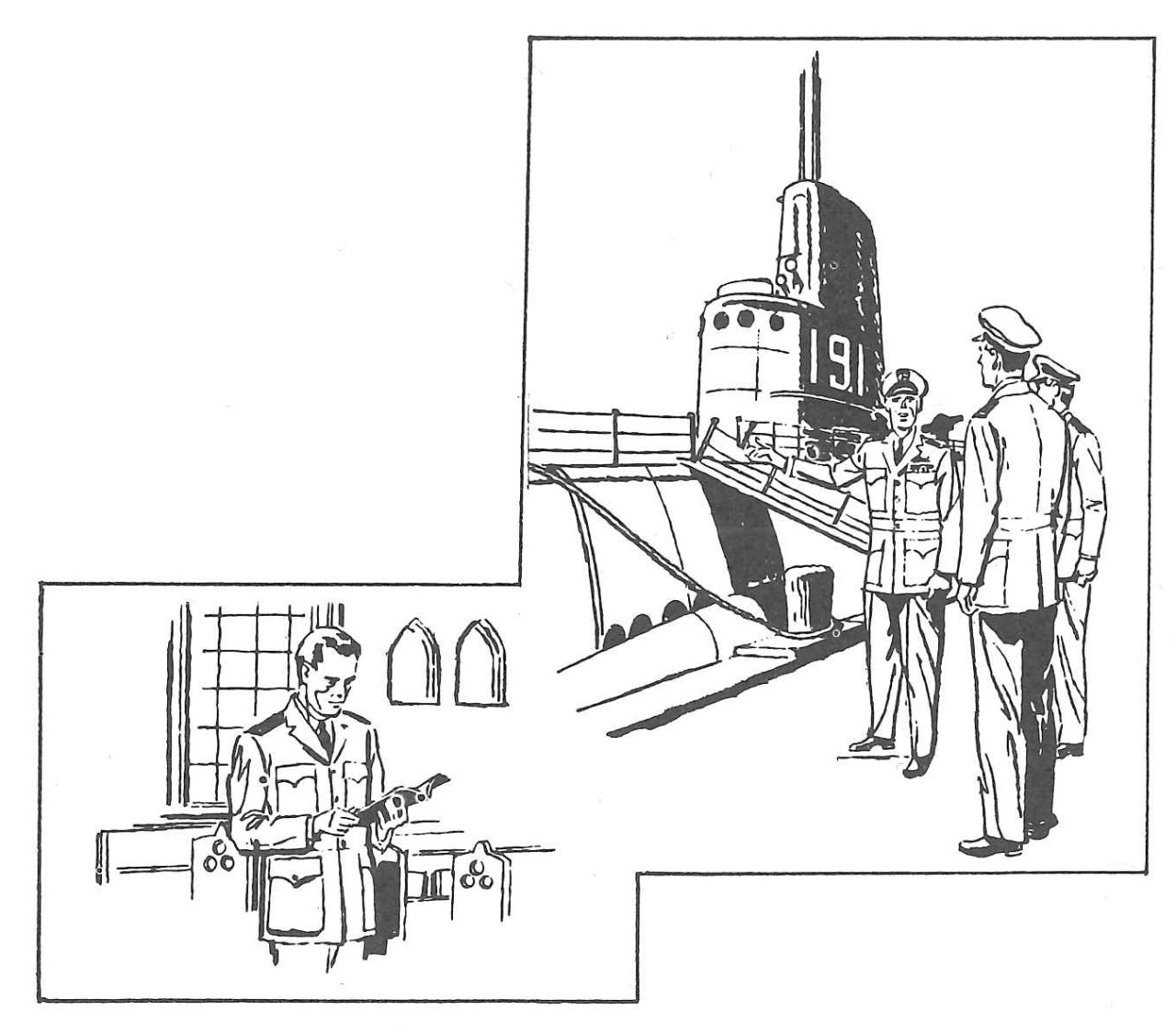
Chapter Two
THE SPIRITUAL MINISTRY
THE LAY LEADERSHIP PROGRAM
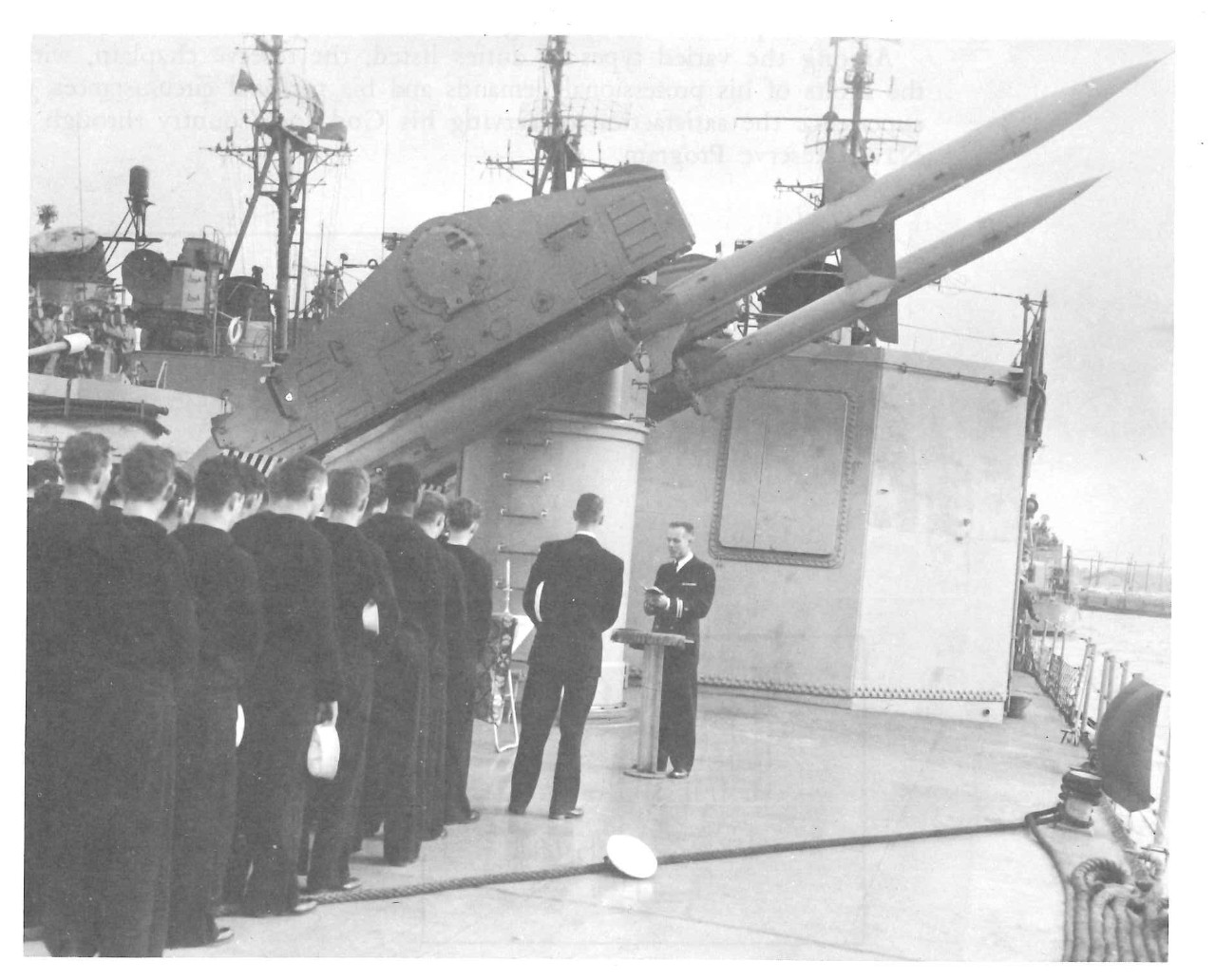
Chapter Two-Part 1
THE SPIRITUAL MINISTRY
1. The Chaplain-A Religious Leader
THE RESERVE
CHAPLAINS’
ESSENTIAL
ROLE
References
(M-2)
(M-3)
(M-4)
(M-18)
(M-22)
(M-23)
THE NAVAL CHAPLAIN IS EXPECTED to conduct his ministry and religious stewardship in the spirit and tenet of the church in which he is ordained. When a Reserve chaplain is assigned to duty at a Naval, Marine Corps or Coast Guard activity he “shall be responsible for the performance of all duties relative to the religious activities of the command.”
The chaplain also carries responsibility of setting an example. He is the exemplar of religious living; the leader in performance of divine worship; the one who keeps the fame of faith aglow when troubles and perplexities threaten to extinguish the flame. He administers in the name of God.
Frequently he will come into contact with personnel who are distant from the practice of any faith. This is both a challenge and a responsibility. What he says will not be so important as what he does, and what he is.
2. Religious Services and Ministrations
MULTIPLE
DRILLS
Reference (d)
WHEN A CHAPLAIN IS ASSIGNED to appropriate duty with or without pay at a Naval, Marine Corps or Coast Guard Reserve Activity, he will be obliged to devise in discussion with the commanding officer, a schedule of ministration which will fit into the crowded schedule of required training. The chaplain should not expect to have the same extended opportunity for his activities which he would ordinarily have in a full-time active duty assignment. It is possible, however, for him to develop an effective program within the obvious limitations.
(1) Divine services may be held at the discretion of the commanding officer, and, according to the availability of the chaplain, when multiple drills are held on Sunday. These may be conducted immediately prior to muster or at some other period during the day. The chaplain should be cognizant of and arrange for church parties to Divine services other than those conducted in the reserve activity.
(2) Public prayer at mustering ceremonies on week-days can frequently be arranged with the consent of the commanding officer.
9
THE CHAPLAIN’S
PROGRAM
AT
RESERVE
TRAINING
CENTERS
References
(M-4)
(M-18)
(3) When requested by members of the command, a chaplain may serve at funerals, weddings, baptisms, etc. The chaplain should, however, ascertain whether the person or family making the request is affiliated with a civilian church or synagogue. In the absence of such affiliation, the chaplain may feel free to accede to the request. But he must always be aware of two customary limitations: first, it is unethical for a Naval chaplain to proselytize without prior initiative on the part of the person involved; and second, the reserve chaplain should always seek to strengthen the ties of reservists with civilian churches and synagogues-he must not regard of reservists with civilian churches and synagogues-he must not regard himself as a supplanter of, or even a substitute for, the civilian clergyman.
(4) The chaplain should, if possible, have office space of his own-plainly marked and easily accessible. Inspirational literature of all faiths can be made available there. Here he may conduct voluntary Bible study groups and other classes after drill hours. (Ecclesiastical gear and religious supplies should be secured from the District Chaplain.)
THE CHAPLAINS’
RELIGIOUS
POSTER
SERIES
(5) Religious posters should be displayed in prominent locations to encourage religious affiliation, worship attendance and high moral standards. A church and synagogue directory should be posted in an appropriate place.
(6) The chaplain should seek to interview each member of the command and to keep a record of the interview. He should endeavor to know the religious preference of each man and should assist, where possible, in strengthening the reservist’s spiritual life in accordance with his religious leanings. Whenever possible, affiliation with a civilian parish should be encouraged. In case of emergency, the chaplain should be prepared to serve so far as desirable, or to call upon a civilian clergyman as appropriate.
THE
CHAPLAIN’S
“MESSAGE”
IN THE
ACTIVITY’S
NEWSPAPER
Reference (M-17)
(7) The chaplain may send a letter of greeting to each reservist’s family assuring them of his personal interest and spiritual concern, and of the Navy’s concern with the reservist’s spiritual life.
(8) In case of extended absence on the part of a reservist due to hospitalization, the chaplain can call on him in his own name and in the name of the command.
USE OF
TRAINING
FILMS
References
(M-15)
(M-16)
(0) The chaplain may provide devotional or inspirational messages for the activity’s newspaper, and seek to have a “religious thought of the day” published in the plan of the day.
(10) The chaplain may find it possible to arrange for fitting religious films to be shown when other films are schedule, and extra time is available.
3. Counseling
THE
WELFARE
OF
PERSONNEL
References
(M-2)
(M-4)
(M-14)
(M-22)
THE QUESTION IS NOT whether the officers and men require counseling; nor is the question related to the reserve chaplain’s qualifications as a counselor. Many members of any given group of people will at various times be in need of counseling; this applies to the personnel associated with a Naval, Marine Corps or Coast Guard Reserve activity. Every Naval chaplain is assumed to have developed facility, insight, and understanding as a counselor. The problem is, rather, how to develop an awareness of the chaplain’s availability as counselor in the minds of the many men who are in his presence only once a week for a few hours.
The following suggestions may prove to be helpful:
(1) He should be available before, during and after drill session.
10
(2) He should make an effort to be seen by as many men as possible at drill sessions.
(3) The commanding officer should be asked to emphasize the availability of the chaplain for counseling at every appropriate opportunity; such announcement should indicate the desirability of seeking the chaplain’s assistance in the consideration both of technical, professional Navy problems, and those of a more personal nature. The chaplain is not present merely to help on Naval matters; all human cares and concerns fall within his purview.
(4) The chaplain’s office should be located in an accessible place; everyone should know where it is.
(5) The more men the chaplain comes to know on personal terms, the more counseling problems will be brought to him; the more confidence the men develop in him over the years, the more willing they will be to bring their problems to him.
4. The Casualty Assistance Calls Program
THE NAVY’S
SYMPATHY
FOR THE
BEREAVED
Reference (M-7)
RESERVE CHAPLAINS SHOULD be aware of the Casualty Assistance Calls Program (CACP) which the Navy developed in 1955. It provides for the personal visit of an officer of the Navy to the family of each person in the Naval service who dies while on active duty, active duty for training, or inactive duty training. The visit is specifically designed to assure the family of the bereaved of the Navy’s sympathy. All reserve chaplains should acquaint themselves with the Casualty Assistance Calls Program Manual.
THE NAVY’S
SYMPATHY
FOR THE
BEREAVED
Reference (M-7)
The Casualty Assistance Calls Program Manual specifically urges District Commandants to designate a chaplain of the same faith as the deceased to accompany the Casualty Assistance Calls Program officer on the first casualty call. Chaplains perform a truly religious mission when they accompany Casualty Assistance Calls Program officers on such calls. Chaplains associated with Navy, Marine Corps and Coast Guard Reserve Activities will, of course, render invaluable assistance to this program through their close association with the members of the unit which they serve, and may be assumed to be involved in casualty calls whenever the need arises.
11
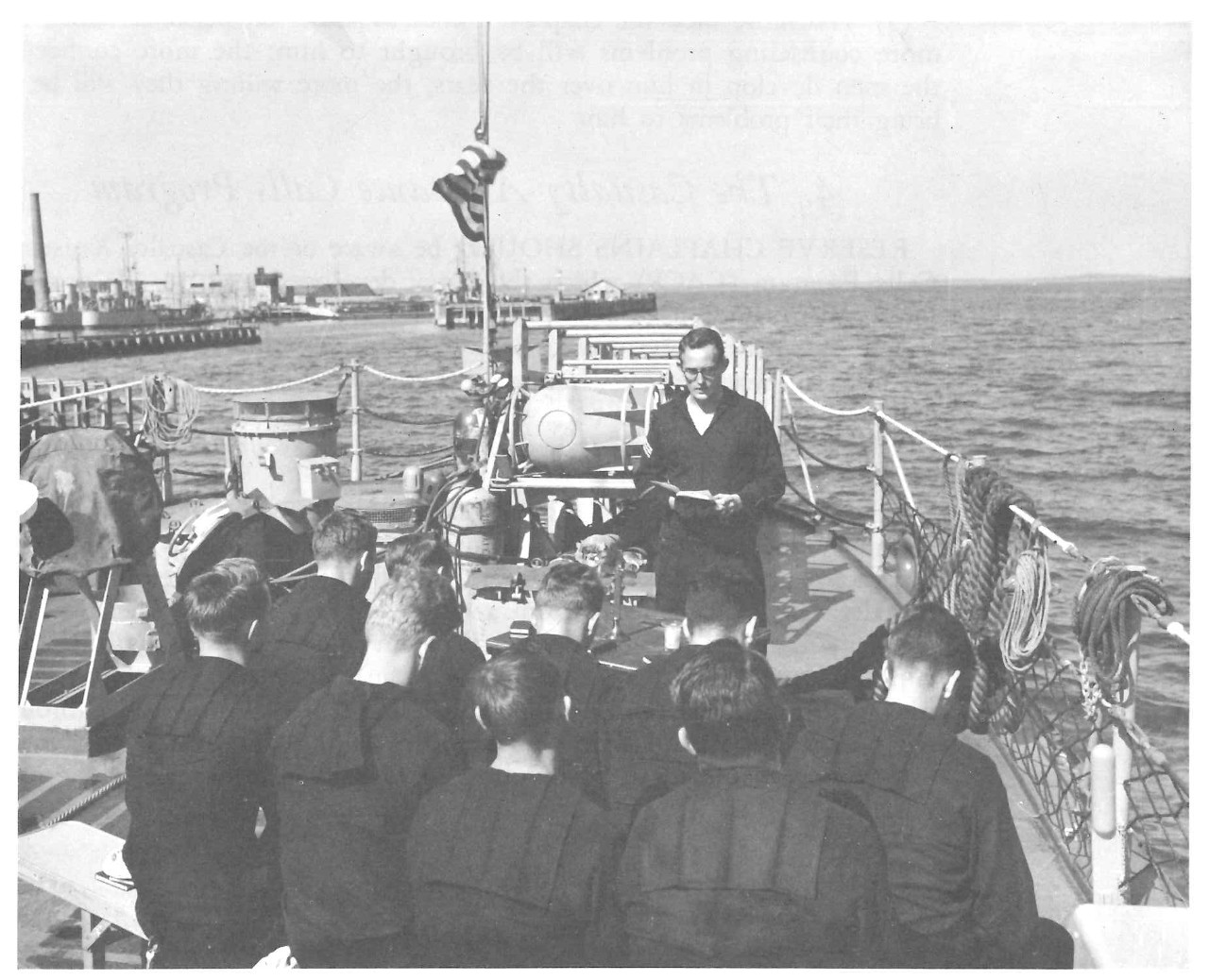
Chapter Two-Part 2
THE LAY LEADERSHIP PROGRAM
1. Preliminary Information
THE
CHAPLAINS’
RESPONSIBILITY
IN THIS
PROGRAM
References
(M-4)
(M-18)
SINCE IT IS THE DUTY of the chaplain to encourage religious activity for all personnel, the lay leadership program has been developed. Men have in the past and will continue to gather under the leadership of a devoted layman to worship Almighty God despite the absence of their respective chaplain. It is the policy of the Chaplains Division to encourage and supervise this worthy religious expression.
It is the official responsibility of the commanding officer with the advice and assistance of the appropriate Supervisory Chaplain to appoint the necessary lay leaders. Practically, however, as implied in Part 1 of this chapter, the chaplain must devise, organize and supervise the lay leadership program.
Within the limitations prescribed below for each faith, all religious groups permit and encourage, in the absence of their ordained clergy, some form of public worship or devotion under leadership of laymen. The chaplain should bear in mind that the character, capability, performance, and appearance of the lay leaders reflect not only upon himself but directly upon the prestige of religion in general. Prospective lay leaders should be personally interviewed by the supervising chaplain, to ensure that they are well motivated for such an assignment, that they are conscientious adherents and proper representatives of their respective faiths and that they hold good reputations among their shipmates.
2. Limitations to Lay Leadership Functions
WHAT THE
LAY LEADER
CANNOT
DO
References
(M-4)
(M-18)
THE CHAPLAIN AND LAY LEADER should bear in mind the following limitations with respect to the latter’s activities:
(1) Personnel of the Navy, except for duly commissioned chaplains, will not administer sacraments at any military activity without specific permission of the Chief of Naval Personnel. The only exception to the above is Baptism “in extremis.” When no chaplain or civilian clergyman is available and death seems imminent and in accordance with the laws of the denominations involved, a layman may baptize using the ritual of the church.
13
(2) The canons of the Roman Catholic Church prohibit preaching by laymen. The public reading of the Epistle and Gospel of the particular Sunday and the recitation of the Rosary is considered the basic elements of the Catholic lay service.
(3) Lay leaders should refrain from specialized tasks, such as personal counseling, which requires special training and from an activity which presume ordination by a religious body.
3. Ecclesiastical Equipment and Supplies
HOW TO ORDER
PUBLICATIONS
AND SUPPLIES
See also
Reference
(M-18)
IT IS ANTICIPATED that basic ecclesiastical equipment will be made available to lay leaders within the limitations imposed by appropriations. Testaments, Sunday Missals, Jewish Prayer Books, Hymnals, etc., should be maintained in quantity for distribution to lay leaders. These may be obtained by submission of Form DD-1149, Reference Index of Forms and Publications, FPSO Instruction 5600.1B. Special note should be taken of the new Armed Forces Hymnal published in 1959.
Other supplies, e.g., tapes, recorder-reproducers, record players, etc., which are purchased from the Chief of Chaplains allotment will be issued, depending on funds available, to Supervisory Chaplains for distribution to lay leaders. The chaplain should send all of his requests for supplies to the supervisory chaplain. The lay leaders should send his requests to the chaplain of the command or next senior command with a chaplain.
4. How to Assist the Lay Leaders
LAY LEADER
SUPERVISION
IN SUPERVISING THE ACTIVITIES of lay leadership and encouraging the religious activities of other faiths the following sources of information will prove helpful to the chaplain in the practical carrying out of the religious program.
The chaplain or lay leader should, with the commanding officer’s permission, invite civilian clergy from a nearby community to come aboard and conduct services, or a Church Party should be arranged with local churches and synagogues where personnel can attend their respective places of worship.
5. Lay Leadership-PROTESTANT
PROTESTANT
PERSONNEL
THESE GENERAL INSTRUCTIONS are to be used as guidelines for reserve chaplains implementing a religious program where no chaplain is assigned to a unit or activity. Among the more general facts to bear in mind in the conducting services by qualified laymen are:
a. The entire Protestant Section of the Armed Forces Hymnal is a primary resource. The order of worship printed on page 121 of this hymnal may be used.
b. Special helps such as sermons and sermon outlines as well as other orders of service may be procured from the Chief of Chaplains through the appropriate District Chaplain.
c. Informal Hymn Sings, Bible Classes may be conducted by lay personnel where appropriate.
d. Recordings of the constituent parts of a Navy church service as well as hymns from the Armed Forces Hymnal may be obtained.
e. Bibles, New Testaments, New Testament portions may be obtained from the American Bible Society, or the Gideons.
14
f. Denominational groups also supply ecclesiastical gear, equipment, and religious material when requested.
g. Consideration should be given to the fact that both Protestant liturgical and non-liturgical churches observe many major and minor festivals of the church year. (See Lectionary Armed Forces Hymnal page 421.)
6. Lay Leadership-CATHOLIC
CATHOLIC
PERSONNEL
CATHOLIC SERVICES CONDUCTED BY A LAY LEADER: Quite often in the normal tour of sea duty, a Catholic priest is not available for Sunday Mass. At such times it is entirely fitting and proper and in accordance with Canon Law of the church that services be conducted by the appointed Catholic Lay Leader. There is no church obligation on the part of personnel to attend such a service, but they are strongly urged to participate.
The customary service conducted by a Lay Leader consists in the recitation of the Rosary with excerpts read from the Mass of the Sunday and with meditations read from an authorized Prayer Book, such as Father Peyton’s Rosary Prayer Book.
A small altar, crucifix and candles add to the dignity of the service. Missals and rosaries should be made available to the worshippers.
The Lay Leader should ascertain the Mass for the particular Sunday by using the calendar in the front of the Missal. He should also select a series of meditations for uses from the “Rosary Prayer Book.”
The Lay Leader should introduce himself and outline the purpose of the service. He then announces the page in the Missal for the Sunday’s Mass.
Kneeling down in front, he makes the Sign of the Cross and reads the Prayer before Mass and the prayer for the particular Sunday. While the men are seated he recited the Epistle. The stand while he reads the Gospel and kneel again for the Secret.
He then announces the Rosary, e.g., Joyful Mysteries, and before each decade reads a meditation from the Rosary Book. (The men may stand during the third decade for variation.)
At the end of the Rosary, the “Hail Holy Queen” is recited. The service will be conducted by reciting together the “Act of Contrition” after he has announced “Now let us recite together an ‘Act of Contrition’ for any sins we may have committed during the day.” The Sin of the Cross is then made.
The above service may be varied or added to at the discretion of the individual Lay Leader, using only authorized prayers and meditations.
HOLY DAYS OF OBLIGATION: In the United States the following Holy Days of Obligation are observed and Catholics are obliged to attend Mass on these days, if at all possible. If that is not possible and the operating schedule permits, have Church Call and follow the same schedule as on Sundays. Be sure to read the Epistle and Gospel of the particular Feast Day.
The Immaculate Conception December 8
Nativity December 25
Circumcision January 1
Ascension Thursday 40 days after Easter
Assumption August 15
All Saints November 1
15
FAST AND ABSTINENCE: Catholic personnel in the Armed Forces are dispensed from the law of fast and abstinence on all days of the year except the Vigil of Christmas, Ash Wednesday and Good Friday.
7. Lay Leadership-JEWISH
JEWISH
PERSONNEL
THE SABBATH: The weekly day of rest and prayers for Jewish personnel is Saturday. The chaplain should be cognizant of the fact that the Jewish Sabbath as well as all festivals begin on the evening of the preceding day. As an example: Saturday is the Jewish day of rest; however, the Sabbath begins when the sun goes down Friday evening and ends when the sun goes down Saturday evening. Divine Services should be held Friday evening and Saturday morning.
SPECIAL RELIGIOUS FESTIVALS: The Chief of Naval Personnel promulgates a special directive at the appropriate times of the year which informs all ships and stations that the respective festivals, Passover and the High Holy Days (Rosh Hashanah and Yom Kippur) are days of religious obligation for Jewish personnel and that Commanding Officers are “enjoined to grant leave to Jewish personnel desiring to celebrate those occasions when the exigencies of the service permit, or to provide for the observance in accordance with local conditions.”
A CALENDAR of Jewish festivals and Holy Days:
a. Purim.
b. Jewish Passover (eight day duration) is the Jewish festival on which the Seder meal and the ritual is held on the first two evenings of the first two days. The Jewish Welfare Board, in cooperation with the Armed Services, plans yearly the distribution of Passover supplies well in advance of a festival. Requests for such supplies should be directed to the Supervisory Chaplain via the Commanding Officer.
c. Shabust (Jewish feast of weeks).
d. The High Holy Days-Rosh Hashanah (Jewish Religious New Year) and Yom Kippur (Day of atonement). These two Holy Days, begin and end respectively a ten day period known as the High Holy Day Season.
The above are the main Jewish festivals celebrated by all three groups (Reform, Conservative, Orthodox). Other days of religious obligation should be encouraged and facilitated whenever possible. No specific dates are listed since the Jewish Holy Days are observed according to the Hebrew calendar. Small pocket calendars are published and distributed yearly by the Jewish Welfare Board which gives the comparable date on the regular calendar.
ECCLESIASTICAL EQUIPMENT: Most of the Jewish religious supplies, materials, pamphlets, prayer books, Jewish calendars, etc., are obtainable from the National Jewish Welfare Board. All requests should be directed to the Supervisory Chaplain via the Commanding Officer.
16
Chapter Three
NAVAL LEADERSHIP AND CHARACTER EDUCATION
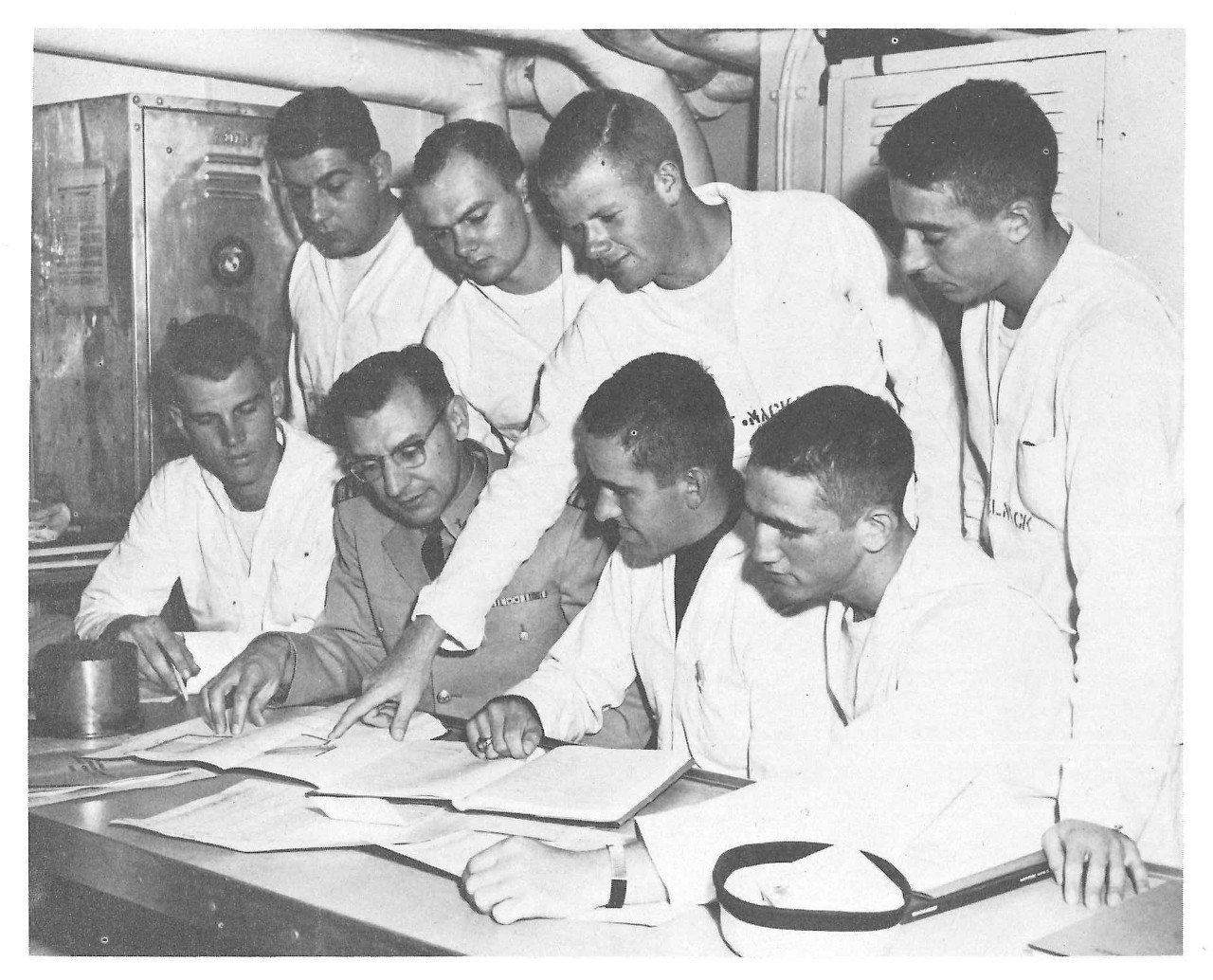
Chapter Three-Part 1
THE NAVAL LEADERSHIP PROGRAM
1. Protection of Moral Standards
RELIGIOUS
AND
MORAL
WELFARE
References
(M-2)
(M-4)
(M-14)
NAVAL LEADERSHIP means the art of accomplishing the Navy’s mission through people, or as the Chief of Naval Personnel has put it, “Leadership can be defined as that aspect of personnel management that involves ethics as related to behavior.” The Navy has since its inception held the Commanding Officer responsible for the religious and moral welfare of the men as well as for their training. From the first Regulations for the Navy of 28 November 1775 the traditional requirement has been maintained.
As Navy Regulations, 1948, Article 0702A clearly states: “All commanding officers and others in authority in the naval service are required to show in themselves a good example of virtue, honor, patriotism, and subordination; to be vigilant in inspecting the conduct of all persons, who are placed under their command; to guard against and suppress all dissolute and immoral practices.” Moreover, Article 0709 makes the Commanding Officer responsible for the welfare of personnel within his command: “The commanding officer shall use all proper means to promote the morale, and to preserve the moral and spiritual well-being of the personnel under his command.”
Not only has the Navy insisted that the Commanding Officer is responsible for the qualities of leadership and the state of morale in his command, but it has also stated that all naval personnel have a moral obligation in their conduct. “All persons in the naval service shall show in themselves a good example of subordination, courage, zeal, sobriety, neatness, and attention to duty. They shall aid to the utmost of their ability, and to the extent of their authority, in maintaining good order and discipline, and in all that concerns the efficiency of the command.” (Art. 1210.)
On many different occasions in the history of the Navy, programs for character education have been developed by energetic commanding officers and chaplains. These programs grew in number during and after World
19
THE
CHARACTER
EDUCATION
PROGRAM
Reference
(M-14)
War II. Subsequently, on 26 May 1951 the Secretary of Defense, George C. Marshall, issued his memorandum on “Protection of Moral Standards.” In this memorandum he stated “It is in the national interest that personnel serving in the Armed Forces be protected in the realization and development of moral, spiritual, and religious values consistent with the religious beliefs of the individuals concerned. To this end, it is the duty of commanding officers in every echelon to develop to the highest possible degree the conditions and influences calculated to promote the health, morals, and spiritual values of the personnel under their command.”
As a result steps were taken to develop a program of Character Education and Moral Leadership resulting in the BuPers Instruction 1743.2 of 3 April 1953. In this instruction the Chief of Naval personnel directed all commanding officers to:
MORAL
LEADERSHIP
Reference
(M-14)
“a. Insure that all personnel are reached by group instruction and by personal interview on all matters that promote the realization and development of moral, spiritual, and religious values consistent with the religious beliefs of the individual concerned. b. Take a personal interest in the off-duty activities of personnel and insure the availability of a well-rounded program of religious, educational and recreational activities.
c. Insure that the type of entertainment presented, the contents of publications sold or circulated, including ship, station, and post newspapers, and the activities of officers’ and enlisted men’s clubs conform to established moral standards.
d. Cooperate with agencies, civilian and military, which may contribute to the moral and social well-being of personnel.”
A KEY OFFICER
IN THE
LEADERSHIP
PROGRAM
References
(M-4)
(M-17)
The chaplain was immediately involved. Since he is a specialist in the field of religious guidance and an advisor to the commanding officer on moral matters, the chaplain was one of the key officers in promoting the moral, spiritual, and religious welfare of personnel. District, fleet, and force chaplains were available to assist commands to which chaplains are not assigned and to advise, counsel, and offer suggestions to unit chaplains concerning their work.
A panel of reserve chaplains has recommended the following suggested program for Naval and Marine Corps Reserve activities not being served by reserve chaplains. For the orientation of all hands there are two lectures of about 40 minutes each. The first “Protection of Moral Standards presentation,” and second, “Moral Leadership.” Thereafter followed an additional program for reserve activities. This was made up of four periods of instruction:
MATERIALS
FOR IMPLEMENTING
THE
NAVAL
LEADERSHIP
PROGRAM
References
(M-14)
(M-15)
(M-16)
(1) “Moral Principals”
(2) “Responsibilities”
(3) “Marriage and the Family Life”
(4) “Sex Education”
If the chaplain desires an alternate series, he should consult the United States Navy and Marine Corps Character Education Series I manual, For Men Only.
Another program of four lectures for rated personnel and officers was developed as follows:
(1) “My World and Me”
(2) “My Values and Choices”
20
(3) “My Freedom”
(4) “My Controlling Purpose”
A broad variety of materials are available for leaders in the Character Education program. Foremost among these is NavPers 15890. Moral Leadership which spells out in detail the philosophy, and techniques of the program and gives lists of materials available. The Character Education program has had a salutary effect and its continuing to be quite productive in developing moral ideals and spiritual values among Naval personnel.
21
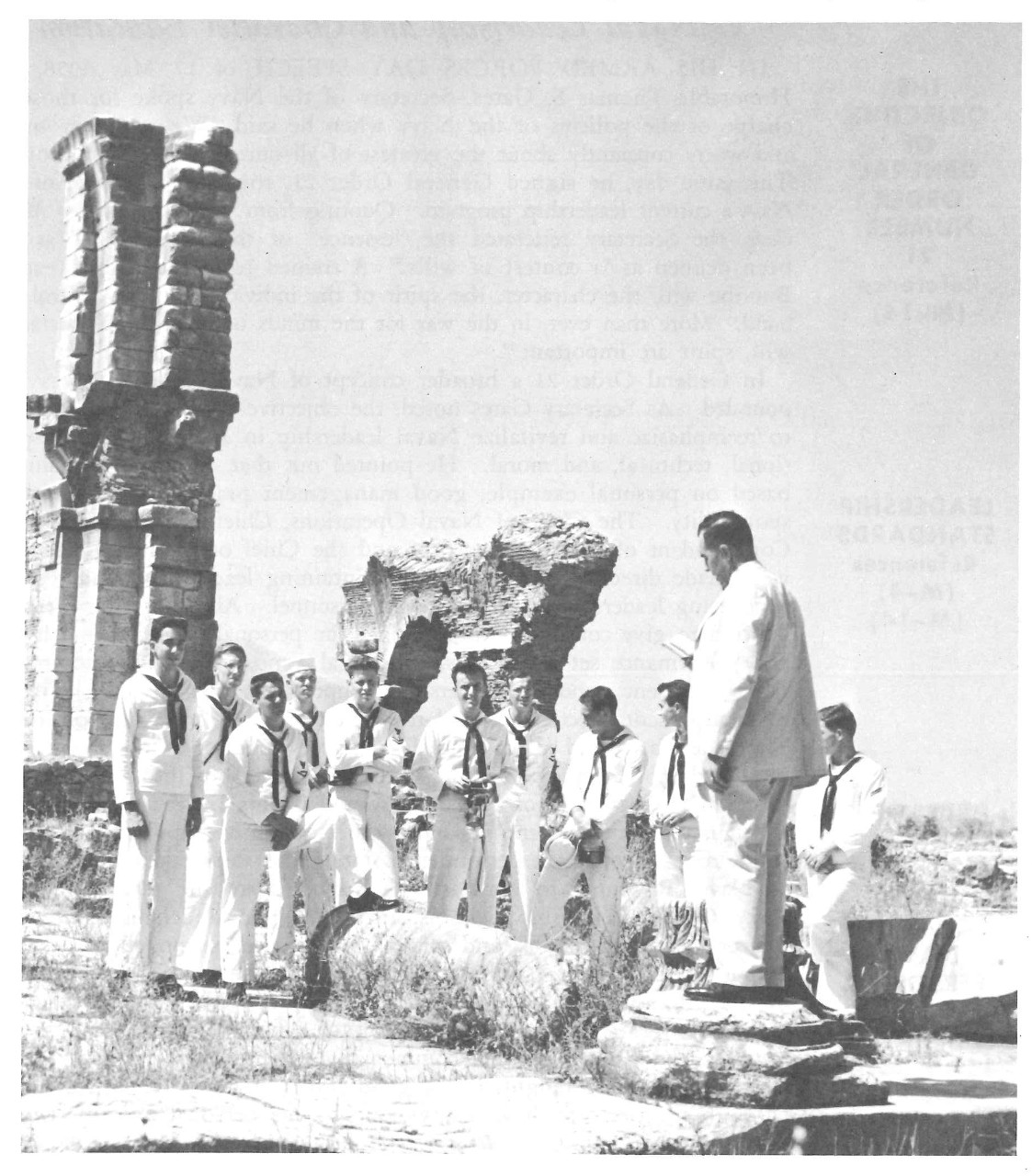
Chapter Three-Part 2
LEADERSHIP
2. Naval Leadership and Character Education
THE
OBJECTIVE
OF
GENERAL
ORDER
NUMBER
21
Reference
(M-14)
IN HIS ARMED FORCES DAY SPEECH of 17 May 1958, the Honorable Thomas S. Grates, Secretary of the Navy spoke for those in charge of the policies of the Navy when he said “We care very much and worry constantly about the greatest of all our resources-our people.” The same day, he signed General Order 21, the basic directive of the Navy’s current leadership program. Quoting from The U.S. Fighting Man’s Code, the Secretary reiterated the “essence” of the problem: “War has been defined as ‘a contest of wills.’ A trained hand holds the weapon. But the will, the character, the spirit of the individual-these control the hand. More than ever, in the war for the minds of men, moral character, will, spirt are important.”
LEADERSHIP
STANDARDS
References
(M-4)
(M-14)
In General Order 21 a broader concept of Naval leadership was propounded. As Secretary Gates noted, the objective of this general order is to reemphasize and revitalize Naval leadership in all its aspects: inspirational, technical, and moral. He pointed out that effective leadership is based on personal example, good management practices, and moral responsibility. The Chief of Naval Operations, Chief of Naval Personnel, Commandant of the Marine Corps and Chief of Industrial Relations were made directly responsible for maintaining leadership standards and conducting leadership training for all personnel. All commands were instructed to give continuing attention to the personal example of behavior and performance set by officers; the moral atmosphere of the command; and the current standards or personnel supervision of men both in regard to management effectiveness and the development of moral responsibility. The order instructed all commanding officers to integrate both the technical and moral principles and practices of leadership into their training programs. The Chief of Naval Personnel by his Instruction 1000.14 of 4 August 1958 defined and expanded the meaning and application of General Order 21 to Naval personnel. Among the steps taken by the Chief of Naval Personnel to
STEPS TAKEN
BY THE
CHIEF OF
NAVAL
PERSONNEL
TO
EMPHASIZE
LEADERSHIP
Reference
(M-14)
emphasize leadership were the establishment of Petty Officer Leadership Schools, increasing the leadership content of Officer Candidate Schools and schools for enlisted personnel, and the development of various training materials. Leadership was pointed out to be the primary ingredient of a successful military life. Good leadership constantly was stressed in the training of officer candidates and in the training of enlisted personnel commencing with the new recruit. Leadership principles are taught, but a good leader acquires that quality only through practice. Such an individual “by his personal example inspires others; by his actions instills a sense of responsibility in others, and by his administrative ability, creates and maintains an efficient organization for the betterment of the Navy as a whole as well as for those individuals for whom he is responsible.”
22
THE
STANDING
COMMITTEE
ON
LEADERSHIP
Reference
(M-14)
It was clearly pointed out that the development of leadership is “the direct responsibility of command” and that this “responsibility cannot be delegated.” It is not enough however, for commanders to understand these ideals and standards of performance. The must ensure by personal example and a program of instruction that leadership is brought home to the division and company officers and then through them to the petty officers and noncommissioned officers and to the men themselves. Earlier, in April 1958, a Special Assistant for Leadership was set up within the Bureau of Naval Personnel. The Special Assistant for Leadership (Pers-12) initiates, develops, coordinates, and disseminates information, ideas, materials, methods of teaching and concepts pertaining to all aspects of leadership-inspirational, moral, managerial. He acts as the executive secretary of the Chief of Naval Personnel’s Standing Committee on Leadership; he ensures the implementation of leadership policies and programs; and he acts as the representative of Chief of Naval Personnel in initiating, making, coordinating, or reviewing research in morale and leadership and in reviewing and evaluating the policies, programs, and actions relating to the enhancement of leadership in naval officers and enlisted personnel of the Regular and Reserve Forces. He administers to such similar teams as may be established by other commands. The Special Assistant also acts as the representative of the Chief of Naval Personnel in keeping informed of, meeting with, and corresponding with other Governmental and civilian agencies and units in matters relating to research in, teaching of, and evaluation of matters of potential interest to the enhancement of naval leadership.
LEADERSHIP
FIELD TEAMS
Reference
(M-14)
Also, a series of eight “leadership field teams” were developed. The BuPers Leadership Field Teams are units of officers and enlisted personnel, who act as representatives of the Chief of Naval Personnel to assist Fleet, Shore, and Reserve commanders and individual commands in their leadership training programs. The Teams make presentations on the leadership program as developed by the Chief of Naval Personnel, demonstrate techniques and procedures, and recommend or supply appropriate materials. In addition to the leadership training prepared for various Naval schools a series of manuals have been developed for all Naval activities. They are the Effective Naval Leadership series and include:
PUBLICATIONS
PERTINENT
TO THE
NAVAL
LEADERSHIP
PROGRAM
Reference
(M-14)
Effective Naval Leadership-A Message to Commanding Officers NavPers 15913.
Effective Division Officer Leadership-A Message to Division Officers NavPers 15914.
Leadership Discussion Guides (Officer) NavPers 15915-A.
Leadership Discussion Guides (Enlisted) NavePers 15916.
Effective Naval Leadership and the Code of Conduct NavPers 15922.
This program emphasizes the continuing activity of line officers in training themselves and those under them in the principles of Naval leadership. Although this program of leadership education and the principles, techniques and procedures of effective management are based on a firm foundation of moral responsibility, it includes many aspects of the Character Education program. This latter program is by no means superseded. In many instances and under many conditions the Character Education program is an effective supplement to the leadership program.
23
Chapter Three-Part 3
The CHAPLAIN AND NAVAL LEADERSHIP
3. Effective Naval Leadership
PRINCIPLES
AND
PROBLEMS
OF
NAVAL
LEADERSHIP
Reference
(M-14)
BEHIND EVERY CAPTAIN’S MAST each AWOL, each disciplinary problem, there is a moral problem. The solution to any moral problem is ultimately a religious one. The world and every many in it is created by God. No institution, organization or individual can long succeed unless its nature is conformable to the will of God. Here is the chaplain’s supreme opportunity and obligation. He must use every means at his disposal to bring men to a powerful faith in God. He must teach and demonstrate the necessity of obedience to God’s commandments. When the chaplain leads his men to be moral beings as God is a moral being, he builds the indestructible foundation for the highest sort of leadership.
It is not only the obligation of the chaplain to be morally correct and spiritually good, but he must also be a worthy example of Naval leadership. In the conduct of his own affairs the chaplain should be an effective part of the command. As well as other Naval officers, he must be aware of costs and personnel needs. A chaplain must know his own job thoroughly and be a proper aid to his commanding officer. It goes without saying that as an officer in the Navy, a member of the Chaplain Corps, a representative of his own church, and a servant of Almighty God, the chaplain has the highest obligation to fulfill in leadership.
THE
MORAL AND
SPIRITUAL
GROWTH OF
NAVAL
PERSONNEL
Reference
(M-14)
One of the most effective ways in which a chaplain functions is in the informal personal relationships he has with officers and men. He can personally guide and counsel as well as inspire. The man-to-man talk quite often is more effective than any number of lectures.
When it comes to the actual functioning of the chaplain in the Navy Leadership Program, he is not the responsible authority to get the program going and to keep it in action. The chaplain is a staff officer in this program-a key staff officer, it is true-but a staff officer. Therefore, the chaplain supports the program in the command through his advice and assistance. He may participate in training leaders, in acting as an expert in ethics, and by giving his experience in counseling and guided discussion methods. The leadership program is a Navy program; the chaplain as an integral part of the Navy will do his best to see that it succeeds.
24
Chapter Four
TRAINING
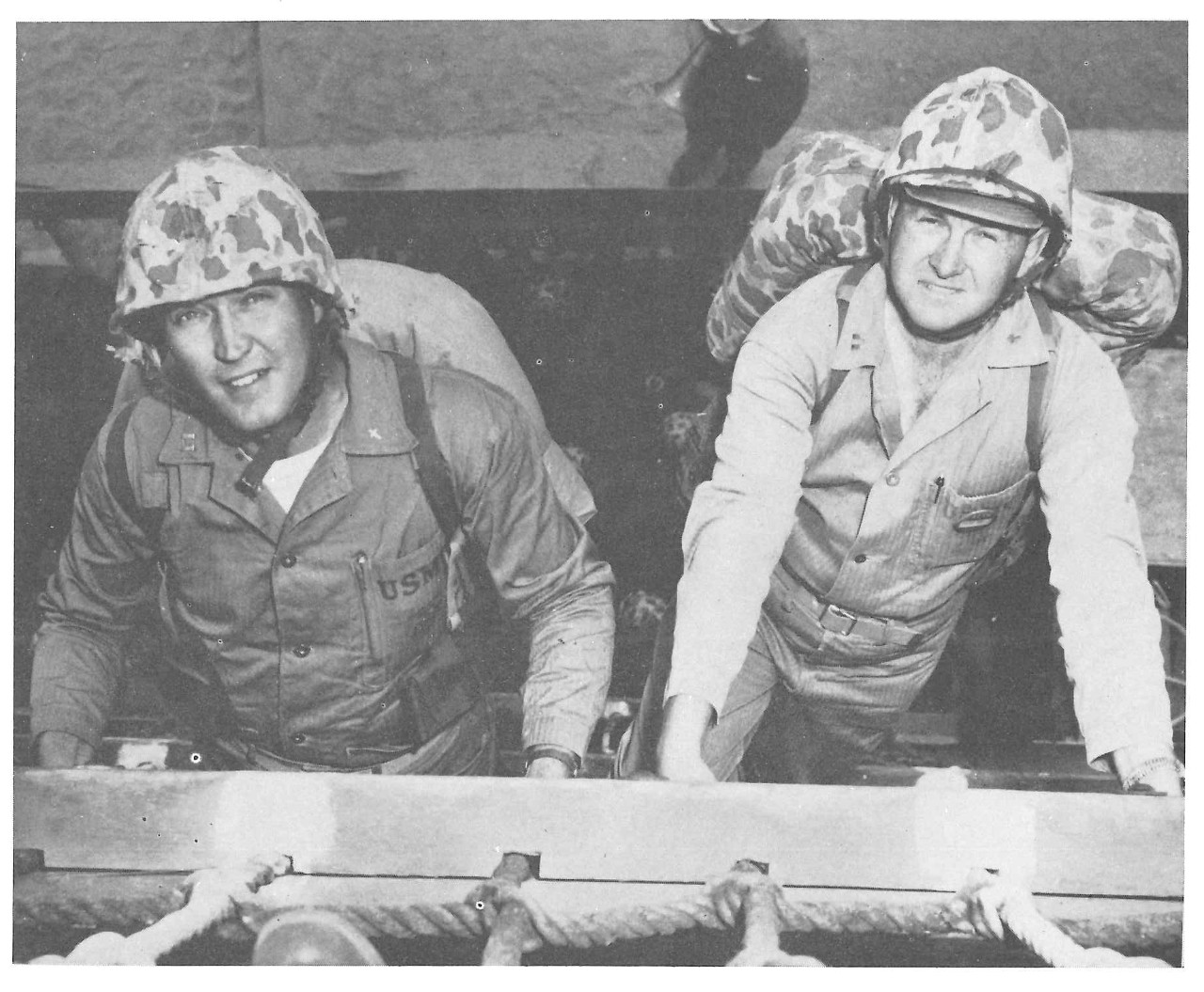
Chapter Four
TRAINING
1. Preliminary Information
TRAINING
FOR THE
NEWLY
APPOINTED
CHAPLAIN
THE NAVY DOES NOT PRESUME to instruct its reserve chaplains in their spiritual responsibilities and obligations. But every chaplain, every clergyman, knows that he must, through prayer, meditation, study, and other spiritual exercises, continue to develop his personal relationship with Almighty God. Similarly, every reserve chaplain realizes that he must continually refine and reinforce his ability to serve in the Navy. There are a number of opportunities for the training of newly commissioned chaplains, and for the continued training of veteran reservists:
TRAINING
FOR THE
VETERAN
RESERVIST
a. The Five-Year Curriculum for Naval Reserve Chaplain Companies
b. Training for Ensigns (Probationary)
c. The Chaplain School
d. Correspondence Courses
e. Naval Reserve Officers Schools
f. Active Duty for Training
g. Uniform Regulations and Reimbursement
h. Informal Training
2. Naval Reserve Chaplain Companies
CURRICULUM
FOR
NAVAL RESERVE
CHAPLAIN
COMPANIES
Reference
(M-6)
CONCURRENT WITH THE PUBLICATION of this Guidebook, a Curriculum for Chaplain Companies has been published and distributed. This Curriculum, developed over a period of two years by reserve chaplains and with the advice and counsel of the District Chaplains, is designed to meet the program needs of the Chaplain Companies. Since their inception in 1948, the Companies have attempted to conduct their own programs, with a varying degree of success. Some Companies meet in or near extensive Naval activities, and are therefore able to draw upon trained Naval personnel for guidance and lectures; other are isolated and must rely upon their own resources. Virtually all of the Companies’ members have expressed the need for guidance in planning their programs.
The Curriculum is the first organized effort to present an integrated course of study. It consists of a series of programs distributed over a period of five years, with twenty for each year. Six major areas of interest are covered in the Curriculum, each divided over the five years:
a. Naval History
b. History and Organization of the Chaplain Corps
c. Character Education
27
d. Chaplain Duties
e. Naval Orientation
f. Ecclesiastical/Public Relations
OBJECTIVES
OF THE
CURRICULUM
FOR
CHAPLAIN
COMPANIES
This course of study will achieve a number of objectives:
a. it will enable the Chaplain Companies to undertake an organized course of training for newly commissioned chaplains who do not apply for immediate active duty;
b. it will offer a channel through which the veteran chaplain will refresh his knowledge of the Navy, and through which he will become informed on newer developments since he last served on active duty;
c. it will serve as a bond of unity for chaplains throughout the country;
d. it will make it possible for a chaplain to move from one unit to another without losing his sense of relatedness to Naval training;
e. it will offer an incentive to unattached reserve chaplains to affiliate with Chaplain Companies;
f. it will offer members of the Companies an opportunity, through their preparation of specific lectures, to become fully informed on those subjects.
3. Training For Ensigns Probationary
PROGRAM FOR
THEOLOGICAL
STUDENTS
(M-4)
(M-22)
QUALIFIED COLLEGE GRADUATES who have been accepted for matriculation, or who are already in attendance at approved theological seminaries may apply for commissions as Probationary Ensigns (Theological) in the Naval Reserve, up to and including the middle year at seminary. Details of eligibility are as follows:
a. applicant must be a male citizen of the United States;
b. applicant must be not less than 19 years of age nor more than 30 at the time of appointment, although the upper age limit may be waived for veterans;
c. applicant must be a graduate of an approved college or university;
d. applicant must be enrolled or accepted for enrollment in the next entering class in an approved theological seminary;
e. if subject to draft, applicant must have Selective Service classification of I-C, IV-A, IV-D, or V-A;
QUALIFICATIONS
FOR
COMMISSION
AS ENSIGN
PROBATIONARY
f. applicant must be able to establish fitness for Naval service through interviews and the submission of academic records;
g. applicant must be endorsed by proper ecclesiastical authority;
h. applicant must be found physically qualified through examination.
INTRODUCTORY
TRAINING AT
THE
CHAPLAIN
SCHOOL
Probationary Ensigns may achieve an introductory training through application for eight weeks training duty with pay at the Officer Indoctrination School, Chaplains, U.S. Naval Schools Command, Newport, Rhode Island, during the summer immediately preceding the final seminary year, or for two weeks active duty for attendance at a training seminar for Reserve chaplains. Both are means whereby the Ensign may achieve a first-hand experience in the Navy. This duty can give the Ensign an invaluable insight into the duties, opportunities, and responsibilities of a Naval chaplain. These are the only periods during which a Probationary Ensign may receive pay from the Navy; the program does not, cannot, by
28
law, provide a financial subsidy for theological students. Probationary Ensigns may join Chaplain Companies.
4. The Chaplain School
CHAPLAIN
SCHOOL
ELIGIBILITY
NEWLY COMMISIONED CHAPLAINS who are accepted for active duty are required to enter a period of training prior to active duty. They are assigned to eight week training duty at the Officer Indoctrination School, Chaplains, U.S. Naval Schools Command, Newport, Rhode Island. Only Reserve chaplains about to serve on active duty and Probationary Ensigns may apply for duty at the Chaplain School.
THE
CHAPLAIN
SCHOOL
CURRICULUM
The staff of the Chaplain School, consisting of three chaplains and one line officer, instructs the trainees in four main units of study: 60 hours on Naval Indoctrination; 66 hours on the duties of the Navy chaplain; 16 hours on the History of the Chaplain Corps; 32 hours on the Protection of Moral Standards, and the Character Education Program. Eight hours of Navy drill are conducted by a Marine sergeant.
In addition, six full days are devoted to visiting Naval activities, including a destroyer, a Naval Air Station, a Sea Bee Training Center, a Submarine Base, the U.S. Coast Guard Academy, a Naval Shipyard, a Fleet Training Center, a Fire Fighting School, and a Damage Control School.
5. Correspondence Courses
PROFESSIONAL
FITNESS
Reference (r)
PROMOTION AND
RETIREMENT
References
(p) and (r)
COURSES
PRESCRIBED
Reference (r)
COMPUTING OF
POINTS FOR
CORRESPOND-
ENCE COURSES
Reference (r)
CORRESPONDENCE COURSES are of great assistance to the chaplain in providing opportunities for enhancing knowledge of the Navy and for fulfilling the requirements for promotion and retirement points.
Retirement point credit is granted to inactive duty officers for satisfactory completion of any naval officer correspondence course evaluated by the Chief of Naval Personnel. Promotion point credit is granted only if the course is one designated for the officer’s grade and designation. The following table lists the title and number of some courses prescribed for chaplains, and indicates the number of points credit and the applicability to various grades. Where a Naval Reserve Officer School Course is available in the same subject, it is also listed.
A number of details in connection with correspondence courses should be noted:
a. Credit for correspondence courses is awarded on completion of courses if 12 points, or of each unit of 12 points if the course is evaluated at more than 12 points.
b. A correspondence course can be taken only once for point credit. However, a major revision of the course (indicated by addition or change of alphabetical suffix to the NavPers number) can be taken for credit even if the earlier course has been completed for credit.
c. Where a correspondence course and a Naval Reserve Officer School course are offered in the same area, credit is granted for either one but not for both.
d. Promotion point credit will be granted for courses complete in grade while on active duty. Retirement point credit is granted for courses completed wile on inactive duty only.
29
6. Correspondence Courses Prescribed for Chaplains Not on Active Duty
RESERVE CHAPLAINS
LTJG to LT and/or LT to LCDR
Earn Promotion Credit for These Courses
Promotion Points
NavPers 10740-A Navy Regulations 24
NavPers 10905-A *The Navy Chaplain 18
NavPers 10906 *History of Chaplain Corps, Part I 12
NavPers 10907 *History of Chaplain Corps, Part II 12
(a) NavPers 10975-A Security of Classified Matter 6
(b) NROS-185 Security of Classified Matter 12
(a) NavPers 10903 Leadership 10
(b) NROS-180 Leadership 12
(a) NavPers 10965 Education and Training, Part I 14
(b) NRSOS-183A Education and Training, Part I 12
(a) NavPers 10993 *Military Justice In The Navy 24
(b) NROS-182 *Military Justice 24
RESERVE CHAPLAINS
LCDR to CDR and/or CDR to CAPT
Earn Promotion Credit for These Courses
(a) NavPers 10720 *Navy Public Information 12
(b) NROS-184 *Public Relations 12
(a) NavPers 10968-A *Personnel Administration 12
(b) NROS-181 *Personnel Administration 12
(a) NavPers 10770-A Foundations of National Power 24
(b) NROS-401 International Relations 24
Naval War College International Relations 54
(a) NavPers 10721 Organization for National Security 10
(b) NROS-301 Organization For National Security 12
Naval War College Logistics I, II, III 72
*These courses earn promotion credit for chaplains of all grades. If a Chaplain desires other courses he may take additional “Alls” as listed in the NAVAL RESERVIST of April 1959 (available at all Reserve activities).
Note.-Courses above marked (a) and (b) are alternate courses in the same subject. Choose one or the other, but not both. Credit is given for only one in each subject.
30
SCOPE OF
INSTRUCTION
FOR ALL
GRADES AND
DESIGNATORS
Reference (s)
7. Naval Reserve Officers Schools (NROS)
SINCE 1953, one hundred and one Naval Reserve Officers Schools, with sixty-nine extensions, have been established throughout the country. The schools have been established to offer training and instruction in an organized fashion to reserve officers, including, or course, chaplains. Courses are offered as alternates to correspondence courses (see the adjoining table). Successful completion of these standardized courses involves one meeting a week (32 meetings is the minimum), and fulfills the requirements for retirement as well as the annual average of 24 promotion points. Attendance at a Naval Reserve Officers School does not preclude active duty for training with pay. Half-year courses may also be taken. Registrars at the schools counsel applicants on courses to be taken. If an officer does not know the location of the nearest Naval Reserve Officers School, a request to the District Commandant will obtain this information for him.
DIVERSE
TYPES
OF DUTY
RECOMMENDED
References
(e) and (f)
8. Active Duty For Training
A NUMBER OF SUGGESTIONS may be made to enhance the value of active duty for training:
a. The reserve chaplain should apply for various types of duty, so as to avoid repetition of the same experience.
b. Even if no training schedule is maintained, the chaplain should strive through discussions with officers and enlisted men in various departments to extend his knowledge of developments in the Naval service.
c. Reserve chaplains are encouraged to ask questions, to seek interviews with supervisory and District Chaplains, and to extend their knowledge of non-spiritual aspects of the chaplain’s duties.
d. The Reserve chaplain should, on his own initiative, become familiar with as many aspects of the activity to which he is assigned as possible.
UNIFORM
ALLOWANCES
AND
CLAIM
PROCEDURES
Reference
(M-3)
9. Uniform Regulations and Reimbursement
IT IS IMPERATIVE that the Reserve chaplain take pride in his appearance. To maintain himself in proper military dress, it is necessary that the Reserve chaplain be aware of current regulations and directives regarding awards, ribbons, etc., as well as the latest information concerning uniform allowances and reimbursements. The following is a summation of this information:
a. Initial Uniform Allowance. Reimbursement of $100 authorized by Section 302 of Naval Reserve Act of 1938 for Naval Reserve officers qualifying prior to 1 January 1953 and reimbursement of $200 for those officers qualifying on or after 1 January 1953 authorized by Section 243 of Armed Forces Reserve Act of 1952.
b. Additional Active Duty Allowance. Reimbursement of $100 authorized by Section 243 (Act of 1952) for qualified Naval Reserve officers reporting for active duty in excess of 90 days on or after 25 June 1950.
c. Uniform Maintenance Allowance. Reimbursement of $50 authorized by Section 302 (Act of 1938) for officers qualifying prior to 10 July 196 who elect such payment, and $50 authorized by Section 243 (Act of 1952) to those eligible Naval Reserve officers qualifying on or after 10 July 1952.
31
d. All Reserve officers are entitle to an initial uniform allowance but once received, no officer is eligible for a future initial allowance.
e. Naval Reserve officers who enter upon a period of active duty, or active duty for training, for a period (continuous) of more than 90 days, where uniforms are required, are entitled to an additional uniform allowance of $100. However, this tour of duty must not follow within two years of a similar period of duty nor must the officer have received his initial allowance during this period.
f. Naval Reserve officers who complete four years of satisfactory service may be entitled to a uniform maintenance allowance of $50. The conditions of eligibility are:
(1) After 9 July 1952, a minimum of 35 retirement points for the performance of duties requiring the wearing of the uniform is a condition of eligibility.
(2) Prior to 10 July 1952, the uniform needed to be worn only on “some” duty during the qualifying year.
WEARING OF
DECORATIONS,
MEDALS AND
AWARDS
Reference
(M-13)
In regard to medals, the Navy and Marine Corps Manual contains detailed information concerning the eligibility for, processing and wearing of awards in the Naval Service. All Reserve chaplains should be responsible for ascertaining those to which entitled and then procuring and wearing the same in the proper order. A chaplain should set an example of leadership in keeping his uniform dress correct and should not feel that the wearing of eligible ribbons is ostentatious.
RESPONSIBILITY
FOR KEEPING
INFORMED ON
NAVAL RESERVE
MATTERS
References
(M-1)
(M-5)
(M-10)
(M-11)
(M-12)
DISTRICT
CHAPLAINS’
NEWSLETTERS
10. Informal Training
IN ADDITION to these formal, organized opportunities for training, every alert, interested chaplain will develop his own habits of keeping informed and ready. Every Naval reservist receives, through the Commandant of his Naval District, the monthly publication, The Naval Reservist. This publication contains pertinent and important information in every issue. It should be scanned for those items which are most applicable to the Reserve chaplain; but other items which are most applicable to the Reserve chaplain; but other items should also be read for the insight which they give into other aspects of the Naval Reserve program.
In addition, the Chaplains Division publishes a quarterly Navy Chaplains Bulletin which gives detailed material of special interest to Reserve and active duty chaplains. Suggestions as to the contents of the Bulletin are always welcomed by the Division.
Every District Chaplain publishes a regular newsletter or bulletin. These publications should be read with care; they are frequently the first report to the Reserve chaplain of important changes in policy as they affect him and his status and his responsibilities.
If a chaplain wants to know the “word,” he will pay careful attention to all of the Naval publications which are sent to him. In this day of tight economy, the chaplain may be certain that money will not be expended for meaningless publications.
In addition, chaplains should be familiar with the contents of pertinent publications which contain ready answers to perplexities and problems. Pertinent texts are listed in the fore part of this Guidebook. They are available at all Naval activities.
32
Chapter Five
ECCLESIATICAL RELATIONS AND RESPONSIBITIES
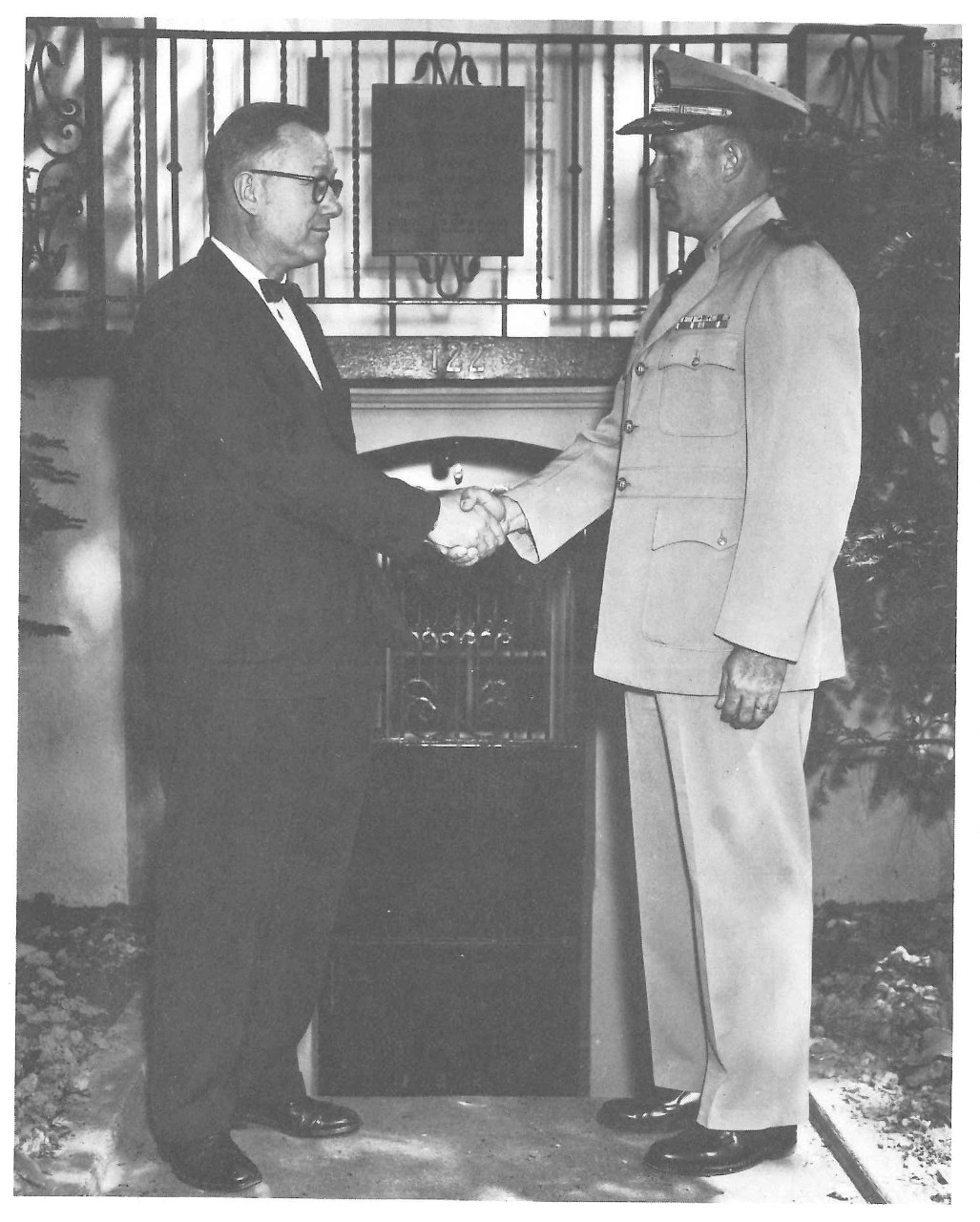
Chapter Five
ECCLESIASTICAL RELATIONS AND RESPONSIBILITIES
1. Preliminary Information
THE
RESERVE
CHAPLAIN
AND THE ENDORSING
AGENCY
Reference (M-4)
THE SUBJECT OF “ECCLESIATICAL RELATIONS” is all too often misunderstood and misinterpreted. It does not merely apply to the Naval chaplain on active duty, but also to the Reserve chaplain. Every Reserve chaplain should keep his endorsing agency informed of his Naval Reserve status: type of duty, promotions, awards, and the like. Every endorsing agency should have up-to-date information on the status of every Naval chaplain, Reserve as well as active duty. In turn, the Reserve chaplain must keep the Navy informed of any change in his religious status, terms of advancement and honors, and particularly in regard to change of denomination. The latter involves, of course, re-endorsement by the news denominational agency. No chaplain who fails to maintain good standing in his own denomination (whatever the denomination’s definition of “good standing” may be) may retain his status in the Navy.
THE
ENDORSING
AGENCY
AND THE
CHAPLAINS
DIVISION
Reference (M-4)
In addition of these basic facts of ecclesiastical relationship, there are numerous opportunities for Reserve chaplains to assist the Navy and the religious community in the area of ecclesiastical relations.
2. The Reserve Chaplain in the Local Community
THE
RESERVE
CHAPLAIN
IN THE
LOCAL
COMMUNITY
References
(M-2)
(M-3)
(M-4)
(M-14)
(M-17)
THE BEST-KEPT SECRET of many churches and synagogues is the Naval Reserve status of the minister, priest, or rabbi. Reserve chaplains should utilize every fitting opportunity to inform their parishioners of their Naval activity. Civilians will derive inspiration from the knowledge of their clergyman’s service, and references in sermons and talks to details of the Navy’s religious and moral leadership program will reassure doubting persons. Who better than the Reserve chaplain can speak authoritatively about the Navy’s concern for the religious and moral welfare of its personnel? Similarly, Reserve chaplains should inform their civilian colleagues of their activity in the Naval Reserve. Civilian clergyman should be told the facts about the chaplaincy, and the Navy’s deep interest in aspects of life which are dear to all clergyman.
35
3. The Support Program
THE
APPROPRIATE
DUTY
CHAPLAIN
Reference (d)
CHAPLAINS SERVING WITH RESERVE ACTIVITIES have many opportunities for enhancing the religious community’s attitude toward religion in the Navy. The following are suggested:
a. At least one communication to the local pastor of every person in the unit, assuring the pastor of the Navy’s concern for the spiritual welfare of all its personnel.
b. A strong effort to draw civilian clergyman into a program of religious ministration for men of faiths other than the chaplain’s.
c. Invitations to civilian clergyman as individuals, or as members of ecclesiastical groups or ministerial associations, to visit the activity.
d. Occasional invitations to civilian clergymen to act as guest preacher on Sundays when multiple drills are held, or to deliver the invocation at the beginning of evening drills.
MULTIPLE
DRILLS
Reference (d)
e. Recommendation to all men of the command to participate actively in the program of their churches and synagogues.
4. Chaplain Companies
CHAPLAIN
COMPANIES
AND
ECCLESIASTICAL
RELATIONS
References
(d)
(M-4)
(M-6)
(M-17)
GROUPS OF CHAPLAINS can often accomplish more than individuals. Chaplain companies should regard their responsibility for ecclesiastical relations as a very special one. The following activities are suggested:
a. Rosters of membership may be filed with the appropriate ecclesiastical bodies, ministerial associations, and other groups, indicating the availability of Reserve chaplains for special needs.
b. Denominational leaders of the community may be invited to meet with the Company and to witness it in action. Such leaders may also be invited to speak on subjects of special interest from time to time.
c. Company members may introduce active duty chaplains to local ecclesiastical groups and ministerial associations.
d. Company members may invite their fellow members to speak at services or other functions, emphasizing the religious fellowship of Navy chaplains.
e. They may occasionally invite civilian clergymen to attend meetings when a subject of particular interest is schedule for discussion.
5. In Conclusion
EVERY RESERVE CHAPLAIN has a continuing assignment from the Navy: to make known to denominational bodies, to fellow clergymen, and to the religious forces of the community, the Navy’s deep and wholehearted concern for the religious, spiritual, and moral welfare of its personnel.
36
Chapter Six
PUBLIC RELATIONS
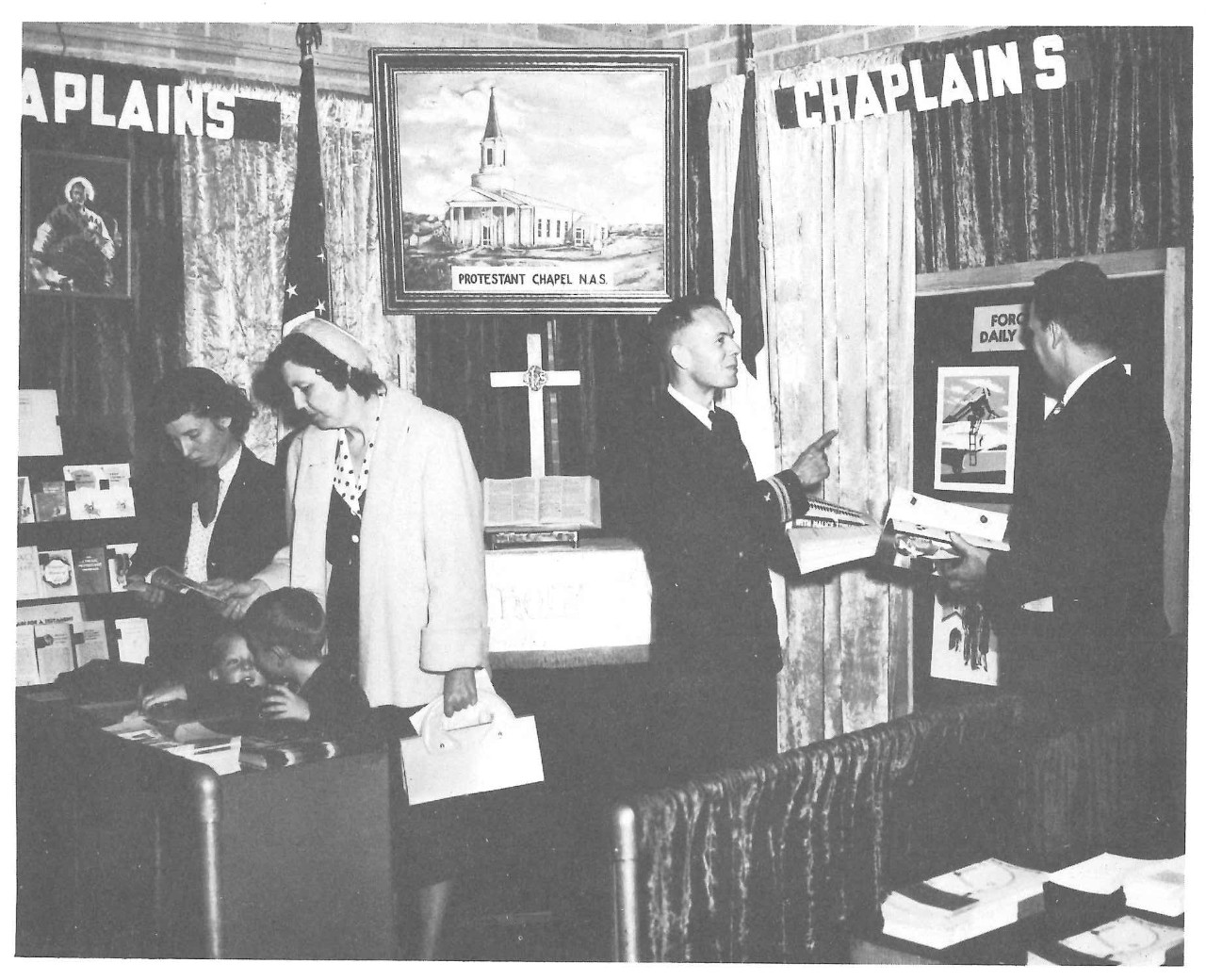
Chapter Six
PUBLIC RELATIONS
RESPONSIBILITIES AND OPPORTUNITIES
1. Preliminary Information
EFFECTIVE
PUBLIC
RELATIONS
References
(M-2)
(M-3)
(M-4)
(M-5)
(M-6)
(M-12)
(M-17)
THE PUBLIC NEEDS TO BE TOLD the story of religion and moral leadership in the Navy. Ordinarily, the public only hears this story in connection with an emergency or other dramatic event. The day-by-day experiences of the chaplain, as the religious leader to the personnel in uniform, are rarely told. The Chaplains Division makes a continuous effort to secure for the Naval chaplaincy program the kind and quantity of public notice with it deserves. But a national program cannot suffice; each Reserve chaplain has many valuable opportunities to provide the facts for a wide, local audience. The following suggestions and procedures are offered, not as an exhaustive survey, but as stimulation to the development of a sense of public relations on behalf of the Navy on the part of each Reserve chaplain.
2. The Reserve Program and Public Relations
BIOGRAPHICAL
SKETCHES
Reference
(M-4)
CHAPLAINS IN
THE NEWS
References
(M-4)
(M-17)
CHAPLAINS’
PUBLIC
ADDRESSES
References
(M-4)
(M-17)
THE RESERVE CHAPLAIN SHOULD include proper mention of his Naval career, assignments, status and rank in the biographical sketch with he uses for various purposes. This is part of his clerical life, an important part of it, not separated from his civilian pursuits. When the chaplain is interviewed by the press, introduced on various speaking engagements, presented to a new church or synagogue, the Navy aspect of his life ought to be given its appropriate emphasis.
Reserve chaplains are often called upon to address civic groups, PTA’s, women’s clubs, and other groups. Whatever the theme or message, references to Naval experiences and episodes may well be used as illustrations. If the mention is natural and the illustration is opposite, the Navy and the public are served without the Navy being the major theme. This does not preclude the use by the chaplain of a few talks devoted largely to the military experience, especially on patriotic occasions, to high school assemblies, and the like. This applies particularly when the chaplain appears on television or radio when he reaches an incalculably large audience. A
39
brief reference to the Navy and its religious program may do much to instill a quiet confidence in the hearts of concerned parents.
Most clergymen ordinarily send to denominational papers and publications important news about their churches and synagogues, and their own careers. Similar use should be made of these media in connection with the chaplain’s Naval career. News of promotions, changes in duty, and interesting experiences should be offered to the denominational press.
KEEPING THE
CHIEF OF
CHAPLAINS
INFORMED
Reference
(M-4)
The Chief of Chaplains is continually in need of interesting and unusual stories about chaplains’ experiences, including reservists’. This includes civilian as well as Naval items. No chaplain should fear being regarded as a “publicity hound.” The Chief of Chaplains urges the submittal of appropriate news stories. He has close contact with ecclesiastical media.
In the interests of public relations, it is important for the reserve chaplain to keep informed on Naval procedures and developments. In this way, the chaplain may react intelligently to complaints or misinformation about the Navy. When unfavorable comments are heard about the religious program of the Navy, and there seems to be some validity to the reports, such information should be forwarded to the Chief of Chaplains. This does not apply to the names of chaplains which might be mentioned.
FRUITFUL
PUBLIC
RELATIONS
References
(M-4)
(M-6)
(M-17)
Especially fruitful public relations can be undertaken by the Reserve chaplain in connection with the activities of veteran groups and scout troops. Boys associated with scout troops, Sea Scouts and especially the newly formed and Navy League sponsored “Cadet Corps” and “U.S. Naval Sea Corps,” will be delighted if the chaplain appears at the troop session in uniform. This experience will establish a deep bond of sympathy and warmth between the clergymen and the youngsters of his community. Veterans have a fondness for chaplains, but if the chaplain is also identified as a reservist, still serving the Navy, he can achieve much good will for his program.
3. The Support Program and Public Relations
LIAISON WITH
THE PUBLIC
RELATIONS
OFFICER
References
(M-4)
(M-6)
(M-17)
MASS MEDIA
ACTIVITIES
References
(M-4)
(M-6)
(M-17)
THE RESERVE CHAPLAIN serving an organized activity should become thoroughly acquainted with the Public Information Officer. The Public Information Officer should be kept informed of all aspects of the chaplain’s program, but especially unusual or interesting events which may be used for publication through mass media.
The chaplain should offer to serve on public relations assignments which may be made by the commanding officer or the Public Information Officer. Requests are made frequently for a Naval spokesman; the chaplain can, by example as well as speaking ability and content, offer an excellent program to various groups which request a Naval speaker.
The chaplain should publicize to the personnel of the command his availability for programs of groups to which the men belong. This will also enhance his relationship with the men.
The chaplain should strive to bring to the Naval activity persons of his acquaintance who are active in mass media: newspapers, magazines, radio and TV. Their prior acquaintance with the activity will serve to secure their interest in the publication of material about the activity.
40
4. The Chaplain Companies and Public Relations
A RESERVE
CHAPLAIN AS
PUBLIC
INFORMATION
OFFICER
Reference
(M-6)
(M-17)
THE COMMANDING OFFICER of each Company should appoint a Public Information Officer for the unit. This officer should have primary responsibility for publicizing the activities and programs of the unit, as well as appropriate activities of the members. This officer should seek to enhance his knowledge of public information duties and opportunities through consultation with the local Public Information Officer or Public Information Officers’ Company. He should also secure a copy of the U.S. Navy Public Information Manual, for guidance in his activities.
Each Company should circularize a list of its members as speakers with appropriate themes and subjects to local civic groups, womens’ clubs, schools, and the like. This may be done in conjunction with the local Public Information Officer.
5. In Conclusion
EVERY CHAPLAIN SHOULD be alert to opportunities to present to the public reliable information about the Navy’s program in the fields of religion and moral leadership. The chaplain has a unique opportunity to serve the Navy, the public, and the cause of truth, through legitimate reference to his first-hand experiences as a chaplain.
41
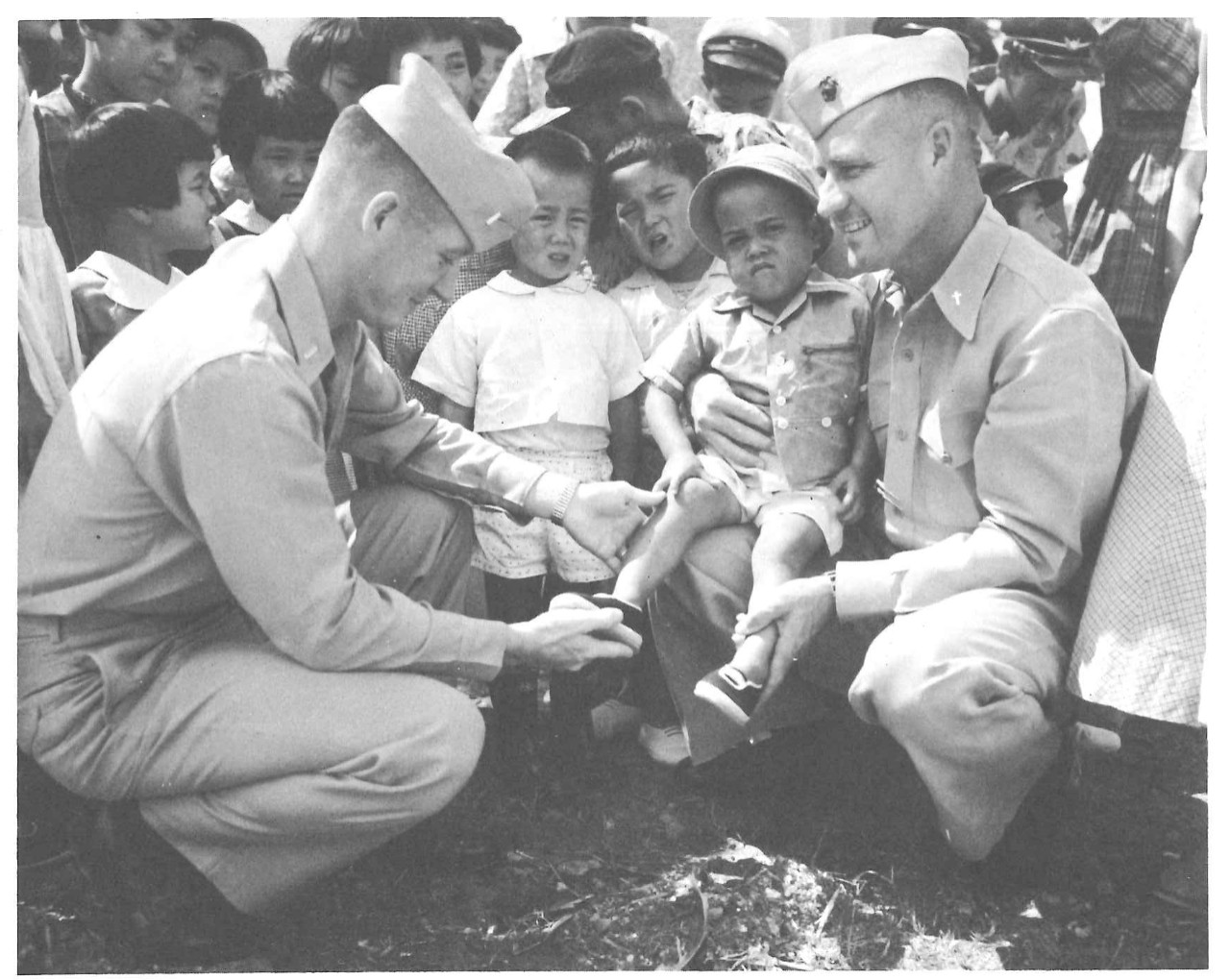
Chapter Seven
PROMOTION AND RETIREMENT
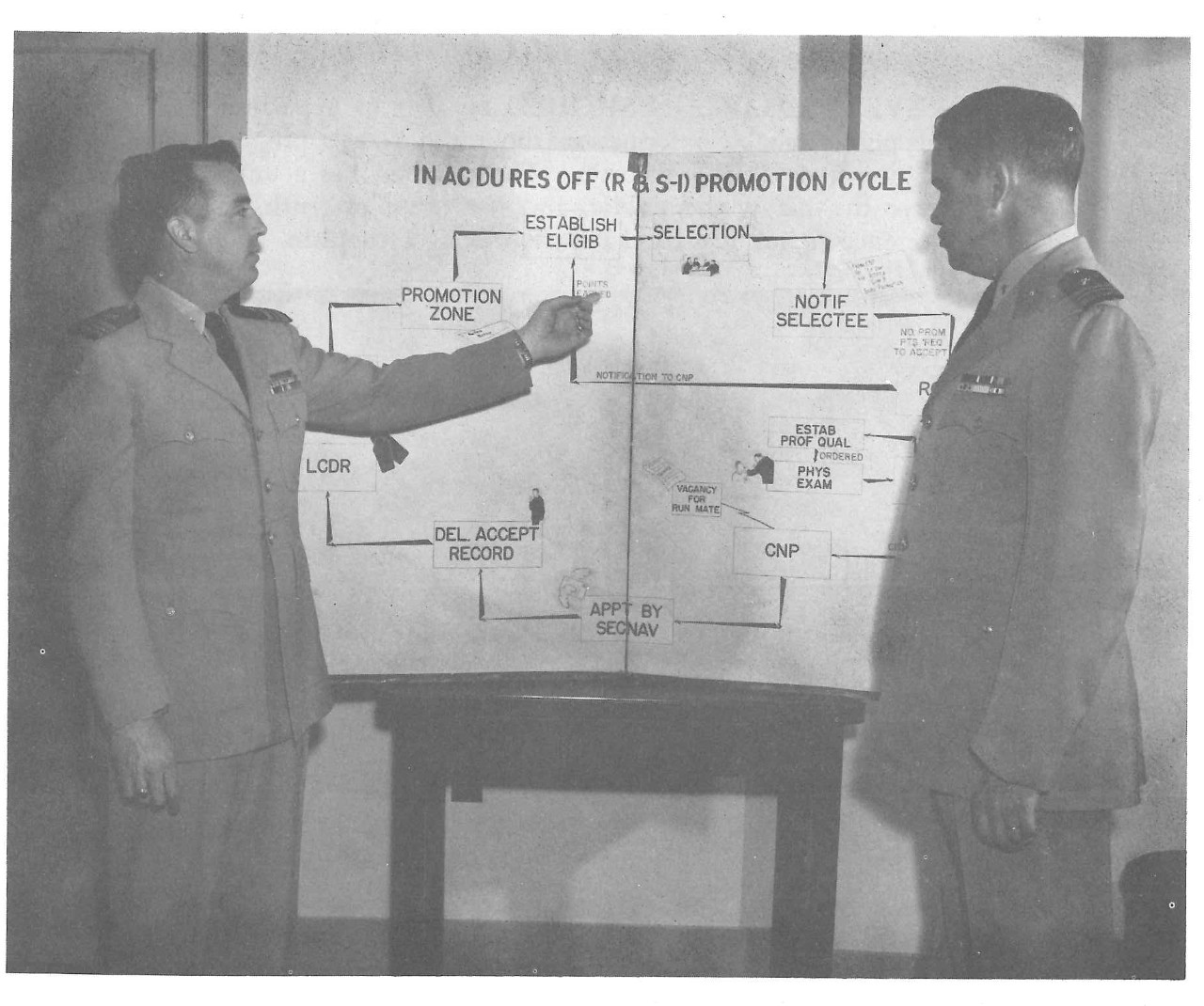
Chapter Seven
PROMOTION AND RETIREMENT
1. Promotion Eligibility
PROMOTION
ZONES AND
PROMOTION
POINTS
References
(q)
(M-1)
(M-11)
TO BE CONSIDERED FOR PROMOTION to the next higher grade, a Reserve chaplain on inactive duty who is in the established promotion zone must have earned 12 retirement points during the Anniversary Year ending in the preceding fiscal year. The promotion zones and dates of meeting of selection boards are publicized regularly in the Naval Reservist, All Hands, and other publications. Each officer recommended for promotion by a selection board is notified of his selection by individual letter; this communication also includes information as to the officer’s satisfaction of all requirements for promotion.
2. The Selection Board
PROMOTION BY
SELECTION
Reference (q)
FITNESS
REPORTS
Reference (q)
FAILING
SELECTION
FOR
PROMOTION
Reference (q)
IT IS NOT POSSIBLE, with any accuracy, to describe in entirety the standards and values which a selection board uses to determine an officer’s fitness for promotion, especially in higher grades where only a few may be selected. Fitness reports, of course, play a large role. Commanding officers have submitted these reports over the long years of a chaplain’s service, noting all of the aspects of an officer’s character, personality, performance, and ability. There are, however, many other aspects of an officer’s service which are taken into consideration, and many of these vary from officer to officer, from duty to duty. All that can be asked is a chaplain’s determination to do his best in every way. Only a selection board can determine how that “best” measures against the “best” of many other officers. Being “passed over” does not necessarily mean inferiority or rejection; it may rather indicate the presence in the same promotion zone of a large number of very superior officers when competition in selection is keen.
3. Professional Requirements for Promotion
PROMOTION TO LT, LCDR or CDR: In addition to being physically qualified, an officer must earn an average of 24 promotion points for each year in present grade, up to a maximum of 144. Years in grade are computed from 1 July following the date of rank, or from date of rank if it
43
PROMOTION
POINTS
FOR
EACH
YEAR
IN
GRADE
Reference (q)
is 1 July, to the end of the same fiscal year in which the officer is selected for promotion. There are two exceptions to this rule:
newly commissioned officers use date of acceptance for their first grade, rather than date of rank; officers reappointed in the same grade from which they were previously discharged or retired use the date of rank in the new commission.
Promotion to CAPT: In addition to being physically qualified, an officer has the option of earning an average of 24 points for each year in the grade of Commander, up to a maximum of 144 points
or
of completing in the grade of Commander, one of the following six courses of study:
(1) Strategy and Tactics. Codes B-27 and B-28 or the complete Naval War College correspondence course issued prior to division into parts.
(2) Logistics. Code B-14 or the complete Naval War College Correspondence course issued prior to division into parts.
(3) International relations. Code A-6.
(4) International Law. Code A-5.
(5) Economics of National Security. Code B-7.
(6) Foundations of National Power and Organization for National Security. Codes A-3 and A-11.
4. Promotion Points
PROMOTION POINTS may be earned as follows:
ACCRUAL
OF
PROMOTION
POINTS
Reference (r)
(1) Two promotion points are awarded for each month of extended active duty, not including training duty. Between 1 July 1950 and 1 July 1955, one promotion point was creditable for such duty. Extended active duty includes temporary active duty which exceeds 30 days; it does not include special training duty of more than 30 days; it does not include special training duty of more than 30 days. The number of months is calculated from calendar date of entry on active duty to calendar date of release from active duty; 15 days or more, but less than a month, is creditable as an entire month; less than 15 days is not so credited.
(2) Twelve points are awarded for:
either by participation in a minimum of 75% of the scheduled drills of a Reserve unit during a fiscal year, but not less than 18 drills;
or
-fourteen days of active duty for training;
or
-fourteen periods of appropriate duty;
whichever is completed first.
MINIMUM
PROMOTION
POINTS
REQUIRED
ANNUALLY
Reference (r)
For fiscal years 1950 through 1955, these twelve promotion points were given for a year of Satisfactory Federal Service (50 retirement points) provided twelve of the retirement points were earned through active duty, ACDUTRA, drills, or appropriate duty. For the fiscal year 1956 and 1957, the minimum number of required drills was 12; and drills attended as instructor or as student in a Naval Reserve Officers School were creditable. For 1958 and thereafter, drills attended as a Naval Reserve Officers School student or instructor are not included in this category.
Reserve chaplains should especially note the following instruction: “During the Anniversary Year ending in the fiscal year immediately preceding the fiscal year in which the individuals concerned will be in the estab-
44
lished promotion zone or otherwise legible for consideration for promotion, all officers shall earn the number of retirement points required to maintain an active status.
(3) A specified number of promotion points are offered for each correspondence course completed, it the course is listed as applicable to the officer’s rank and designator. See the chart in Chapter IV.
CORRESPOND-
ENCE COURSES
Reference (r)
NAVAL RESERVE
OFFICERS
SCHOOLS
COURSES
References
(r) (s)
PROMOTION
POINT
CREDITS
FOR
COLLEGE
COURSES
AND
RESIDENCY
TRAINING
Reference (r)
(4) Satisfactory completion of a Naval Reserve Officers School course for the officer’s rank and designator is also associated with a specified number of promotion points.
(5) Officers enrolled in an accredited college or university may, upon application, be credited with one promotion point for each semester hour or equivalent satisfactorily completed, up to a maximum of 12 promotion points for any one fiscal year. Credit may be requested for courses taken in present grade since 1 July 1950. Promotion points were credited as of 1 July 1957 for courses taken to that date. Subsequently completed courses will be credited as of 30 June of the fiscal year in which completed. Requests for promotion credit for such courses should be submitted by the officer to the Officer in Charge, Reserve Officer Recording Activity, 30th and Fort Streets, Omaha 11, Nebraska, via the command by a transcript of credits from the college or university.
(6) Promotion points are also granted as determined by the Chief of Naval Personnel for the satisfactory completion of other approved training or instruction.
5. Retirement Eligibility
TWENTY YEARS’
SATISFACTORY
FEDERAL
SERVICE
Reference (I)
ANY PERSON WHO HAS COMPLETED twenty years of Satisfactory Federal Service as a commissioned officer, warrant officer, flight officer, or enlisted person, in any branch of the Armed Forces or their Reserve components is eligible, upon application, to receive retirement pay upon or after reaching 60, provided that:
SATISFACTORY
YEARS PRIOR
TO AGE 60
Reference (l)
(1) the reservist served the last eight years of qualifying service as a member of a Reserve component; these eight years need not have been continuous; service on the Honorary Retired List or Retired Reserve subsequent to 30 June 1949 is not creditable for retirement purposes unless such service was on active duty;
(2) the reservist is not eligible for, or receiving, any other retired pay for military service;
SATISFACTORY
YEARS
SUBSEQUENT
TO AGE 60
Reference (I)
(3) if the reservist served prior to 16 August 1945, he must have performed active Federal service during either 6 April 1917 to 11 November 1918, or 9 September 1940 to 31 December 1946, or 26 June 1950 to 28 July 1953;
(4) officers who were appointed prior to 1 January 1953 who cannot complete 20 years of Satisfactory Federal Service for retirement purposes by age 62, but who can complete such service by age 64, may be retained in an active status until the 64th birthday.
6. Non-Creditable Military Service
ALL SERVICE in any branch of the Armed Forces is creditable with the following exceptions:
(1) Inactive and/or non-federally recognized status of the National Guard and Air National Guard.
45
ARMED FORCES
COMPONENTS
WHO MAY NOT
ACCRUE
RETIREMENT
POINTS
Reference (I)
(2) Inactive Reserve Section of the Officers Reserve Corps.
(3) Inactive Officers Section of the Air Force Reserve.
(4) Honorary Retired List subsequent to 1 July 1949 or Retired Reserve except service on active duty.
(5) Service in the Public Health Service or temporary Coast Guard.
(6) Naval Militia Service is creditable only between 16 February 1914 and 1 July 1918. National Guard is creditable, if federally recognized, after 21 January 1903.
(7) Appointed aviation cadet service is not creditable between 1935 and 1942 for retirement purposes, but is creditable in determining rate of basic pay.
(8) Service as Midshipman or Cadet is not creditable.
(9) Time on inactive status list is not creditable for retirement purposes, but is creditable in determining rate of basic pay.
7. Retirement Point Credits
SATISFACTORY
YEAR
AND
ANNIVERSARY
DEFINED
Reference (I)
ALL SERVICE PRIOR to 30 June 1949, with the exceptions noted, is creditable for retirement with pay. After 1 July 1949, no year may be counted as one of the minimum 20 unless it has been a “Satisfactory” year-that is, unless the reservist shall have earned at least fifty retirement points during that “Anniversary” year. (The “Anniversary” year, for reservists who entered the Navy prior to 30 June 1949, will be the equivalent of the fiscal year. For reservists who entered after 30 June 1949, or whose Reserve service was broken after that date, the “Anniversary” year extends from date of entry or re-entry into Reserve service.) Retirement points earned during a year which is not “Satisfactory” are, however, computed into totaling retirement pay. Retirement points may be earned as follows:
GRATUITOUS
POINTS
Reference (I)
ACCRUING
RETIREMENT
POINTS
Reference (I)
APPROPRIATE
DUTY POINTS
CREDITABLE
FOR DRILL
ATTENDANCE
Reference (d)
(1) Fifteen gratuitous points are credited for each year of membership in the Naval Reserve, except for officers on the inactive status list or in the Retired Reserve.
(2) One point for each day of active duty or active duty for training, including travel time.
(3) One point for each duly authorized drill attended in either pay or non-pay status.
(4) Point credits for completed correspondence courses. These are credited in twelve units for the year in which the unit is completed.
(5) One point for each period of equivalent instruction or appropriate duty as authorized by the Commandant or the Chief of Naval Personnel. Credits for the performance of appropriate duty will not exceed the following:
Annually 48
Quarterly 13
Monthly 6
Weekly 2
Daily 2
If two periods of appropriate duty are performed in one day, each period must consist of duty of not less than four hours’ duration.
(6) Point credit as authorized for attendance at certain symposia and conventions (see Chapter I, Section 12).
(7) A maximum of sixty points per year is fixed for all inactive duty training. Active duty and active duty for training retirement point credit may be added to this amount.
46
8. Completion of Twenty Years Satisfactory Service
ALTERNATIVES
UPON
COMPLETION
OF TWENTY
YEARS
Reference (I)
MANY RESERVE CHAPLAINS will meet the requirements for twenty years of satisfactory service long before they reach age 60. The following alternatives are available:
(1) By continuing in an active Reserve status, without necessarily feeling compelled to achieve 50 points per year, the chaplain will add increased years of service for longevity purposes and will increase the number of points of his total Reserve score-both of which will increase the amount of his retired pay. The chaplain will also continue in this manner to place his wide experience at the disposal of the Navy.
(2) The chaplain may request transfer to the inactive status list. He may not earn additional points in this way, but the basic pay for retirement is increased by additional longevity until age 60.
(3) The chaplain may request transfer to the retired reserve. No additional points or longevity are accrued in this status unless the officer is recalled to active duty.
(4) The chaplain may resign. He resumes full civilian status in this way, having no connection with the Naval Reserve except through the assurance of retirement pay after reaching age 60. Upon retirement he and his dependents are eligible for Medicare if he has served on active duty for a period of not less than eight years, not including active duty for training.
HOW TO
DETERMINE
RETIREMENT
PAY
Reference (I)
9. Retirement Pay
THE RATE OF RETIREMENT PAY is the number of accrued retirement points divided by 360 and multiplied by 21/2%, again multiplied by the applicable base pay of the rank in which retired. Maximum retired pay is 75% of base pay.
- Each day of extended active duty counts as one point.
- Before 30 June 1949, fifty points are credited for each 365 days of inactive service.
- A chart containing information about the latest pay scale is appended. Officers may plot approximate monthly retirement pay on the basis of their own service.
THE
CONTINGENCY
OPTION ACT
FOR NAVAL
RESERVISTS
Reference (t)
10. An Annuity For Your Family
DURING THE 17TH YEAR OF SERVICE, and before a reservist completes 18 years of service creditable for the computation of basic pay, (basic pay entry date), he may elect on NAVPERS Form 591 to draw a little less retired pay for himself during his own lifetime after retirement at age 60, thereby assuring his surviving dependents of an annuity after his own death. Four options are offered: annuity to the widow; annuity for a child or children; annuity for both widow and child or children; option to cover the contingency of the beneficiary’s death prior to that of the retired reservist. EVERY RESERVIST SHOULD CONSIDER THE ANNUITY OPTIONS VERY CAREFULLY: the form must be executed before the end of the 18th year of service creditable for the computation of basic pay (basic pay entry date). After the completion of the 18th year, the opportunity has been forfeited. The plan can, however, be modified or revoked before retirement.
512303 O-59-5 47
11. Other Retirement Benefits
PRIVILEGES
OF
RESERVISTS
RETIRED
WITH PAY
References
(I)
(M-19)
(M-20)
RETIRED RESERVISTS ARE ENTITLED to many benefits other than pay. Every Reserve chaplain should familiarize himself with the contents of standard Navy publications such as Navy Guide for Retired and Fleet Reserve Personnel and Rights and Benefits of Navymen and Their Dependents. There are, however, frequent changes, modifications, and developments in this entire field. It therefore behooves the Reserve chaplain on the brink of retirement (whenever that time approaches) to inform himself of the latest up-to-date information on his benefits.
RESERVE
OFFICERS’
RECORDING
ACTIVITY
Reference (I)
12. In Conclusion
EVERY CHAPLAIN SHOULD annually take advantage of the opportunity which is offered to him to write to RORA (Reserve Officer Recording Activity) for information about his current promotion and retirement point status. The form may be obtained from the Supervisory Chaplain or at the Naval Reserve Activity. This is a double check on his own records.
48
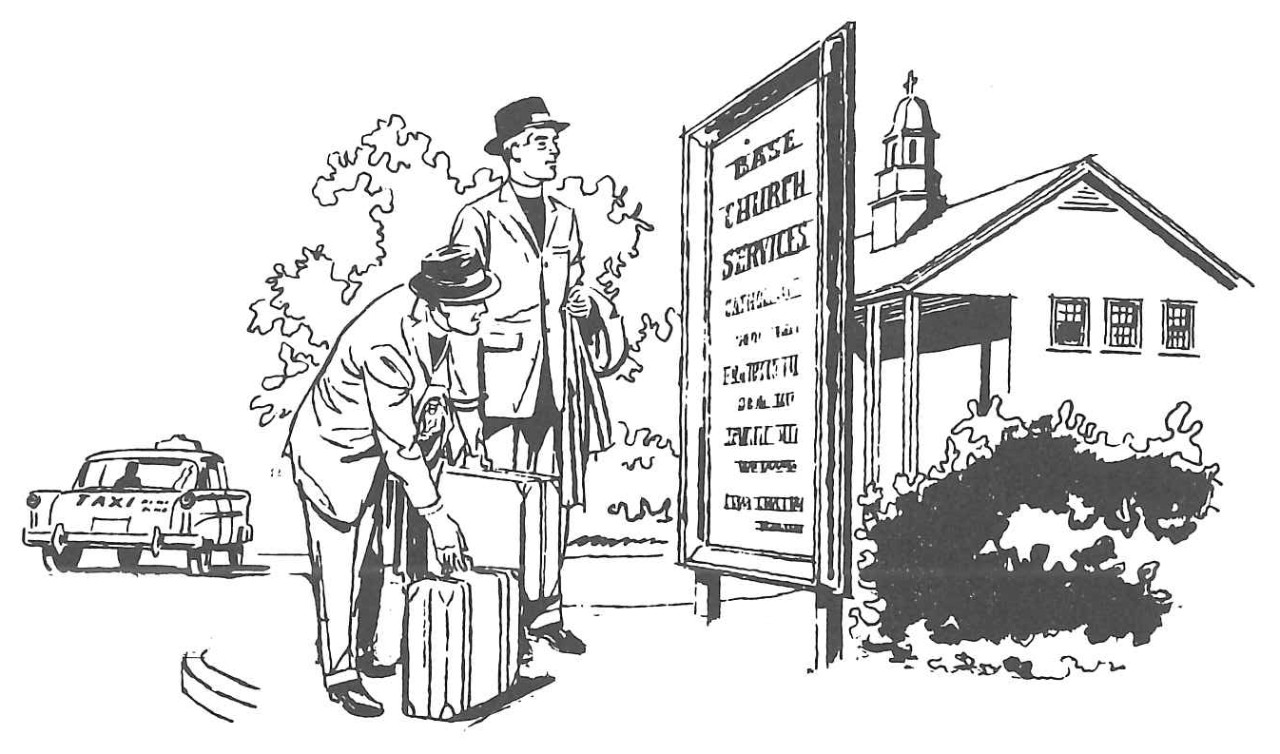
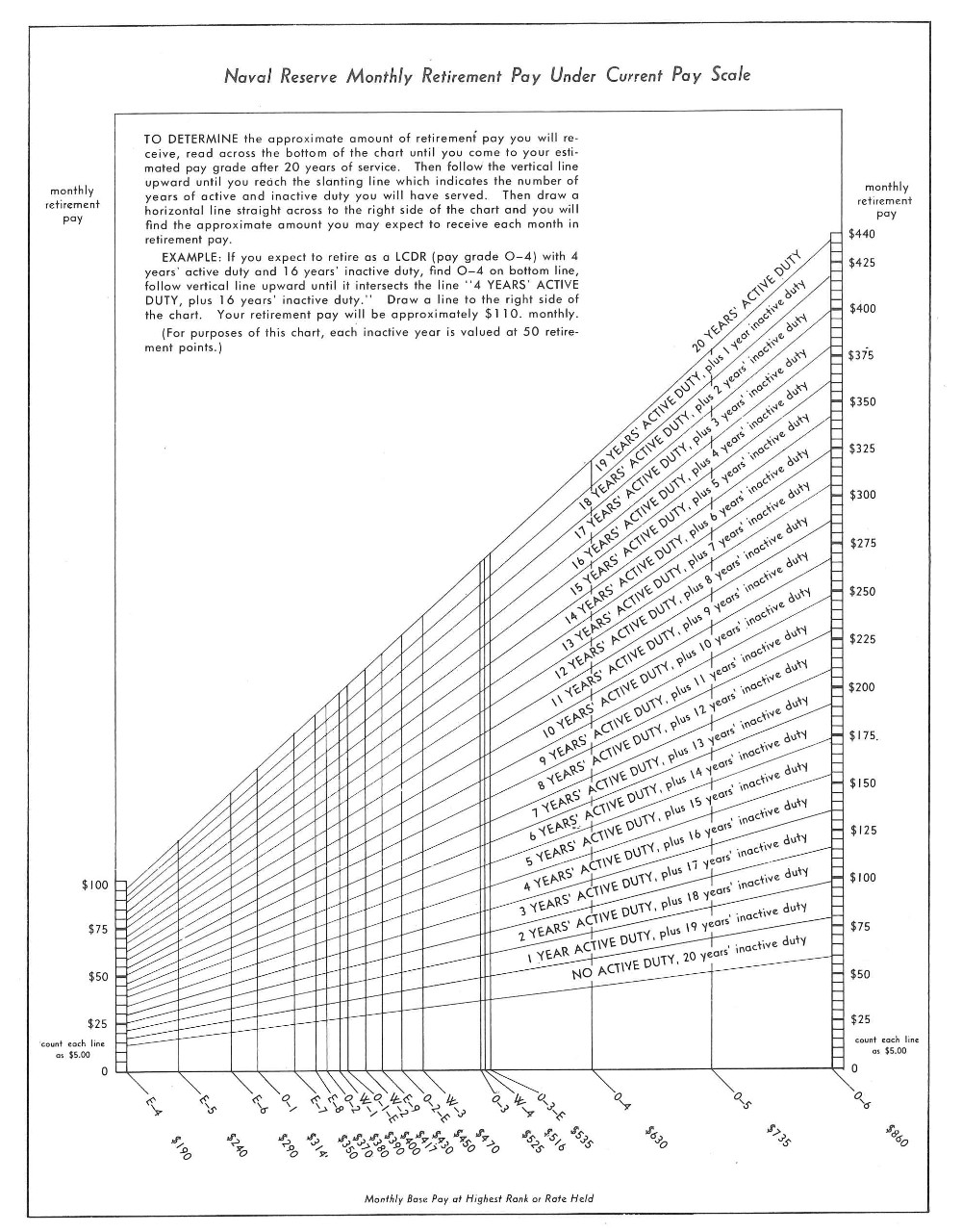
Chapter Eight
PROTOCOL AND REPORTS
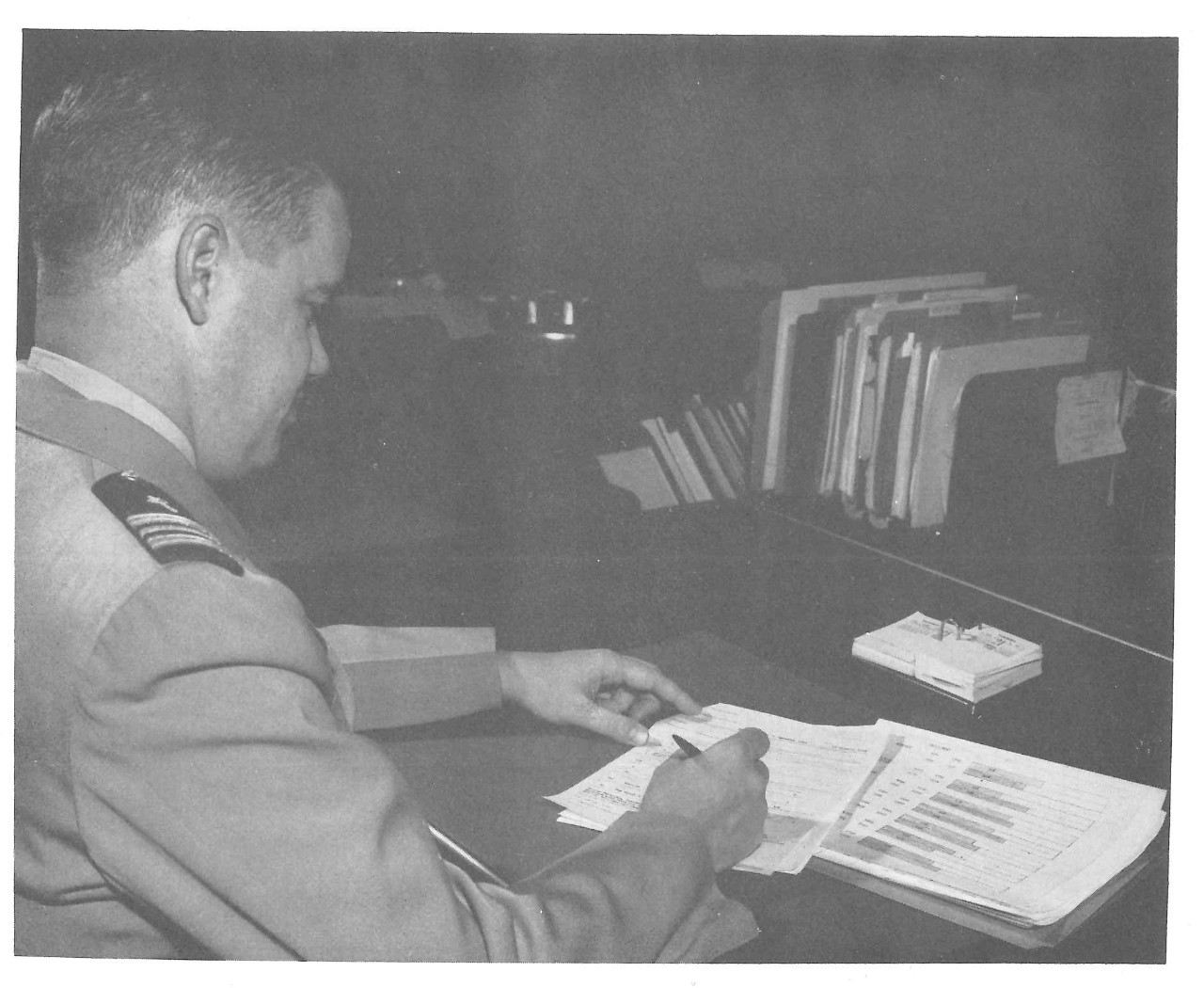
Chapter Eight
PROTOCOL AND REPORTS
1. Preliminary Information
CORRESPOND-
ENCE AND
OFFICIAL
FORMS
References
(M-3)
(M-4)
EVERY RESERVE CHAPLAIN should refresh his memory, from time to time about the proper relationships and forms to be observed by all Naval personnel. Many of these do not apply to some reservists, but all do hold true when the reservist is associated with a Naval or Marine Corp activity, and when he serves on active duty for training. A convenient reference volume for Naval usage is the most recent edition of Arthur A. Ageton, The Naval Officer’s Guide.
One basic principle for every Reserve chaplain’s career is that he read and, when indicated, answer every communication received by him from the Navy. Personal letters cannot be sent to thousands of officers except by an exorbitant expenditure of funds; a processed letter is nonetheless personal in its applicability to each officer concerned. No chaplain should permit official communications from the Navy, or any part thereof, to remain unread or ignored.
SUBMISSION
OF REPORTS
References
(M-3)
(M-4)
Just as chaplains should answer all communications addressed to them, so chaplains are responsible for the submission of a number of regular reports, some of which are required to be submitted by all Reserve officers, others only by chaplains.
2. Fitness Reports
FREQUENCY
OF
REQUIRED
FITNESS
REPORTS
Reference
(M-3)
EACH OFFICER WHO IS A MEMBER of an organized activity of any sort must be appraised by a reporting senior. This applies whether a chaplain serves with a Naval or Marine Corps Reserve activity, with a Chaplain Company or Composite Company, or any other unit. It is the individual officer’s responsibility to deliver to his reporting senior a fitness report worksheet and signed blank fitness report form, generally 30 days prior to the date of the report. Reports must be submitted as of 30 June each year, and in all cases of permanent detachment of the officer or of the commanding officer. Reports on the performance of chaplains serving two weeks active duty for training are also required.
51
Fitness reports are not generally shown to an officer, unless the report indicated “unsatisfactory” conduct or performance. In the latter cases, the reports must be shown to the officer, and opportunity provided for the officer to make a statement.
OPPORTUNITY
TO CONSULT
FITNESS REPORTS
Every officer has an opportunity to consult all of his fitness reports at the Bureau of Naval Personnel (Arlington Annex, Room 3057). Chaplains are urged to take advantage of this opportunity when in the vicinity of Washington. An examination of the reports, chronologically arranged can give the chaplain a view of himself through the eyes of those responsible for supervising his work. He may never have this opportunity in civilian life. One sees one’s attributes, personality, failings, capacities, and see one’s self in this light. Frequently growth of character and personality are observed; sometimes one failing is noted by many reporting seniors. A chaplain can profit greatly from the opportunity to read the record of his career, which, of course, has largely determined the course of his promotions and assignments. If, in examining his fitness reports, a chaplain believes he has discovered errors of fact, he may so indicate by letter to the Chief of Naval Personnel via his commanding officer and the District Commandant. (cf. Sample Forms Pages 7-10.)
3. Annual Qualifications Questionnaire
AN ANNUAL
CHECK ON THE
ADAPTABILITIES
OF ALL
OFFICERS
References
(o)
(M-3)
THIS FORM IS SENT, each year, to all reserve officers not on active duty. It is an essential aspect of the Navy’s effort to utilize, when necessary, all of the varied facilities and qualifications of an officer. It is essential that each officer return the Questionnaire promptly to the District Commandant. Information about a chaplain’s capabilities and training which would have special interest for the Chaplains Division may be sent via the commanding officer and the District Commandant, in a separate communication, to the Chief of Naval Personnel (attn: Pers J).
4. National Agency Check
PERIODIC
SECURITY
CLEARANCE
References
(f)
(M-3)
EVERY RESERVE CHAPLAIN IN A READY STATUS must submit a National Agency questionnaire. These forms are sent automatically to all officers transferring from another type of status to Ready, and to all newly commissioned officers. This is part of a “loyalty” type investigation required by law.
5. Medical Questionnaire
DETERMINING
PHYSICAL
FITNESS
Reference
(M-3)
IN ADDITION TO THE PHYSICAL fitness examinations required every four years, for active duty for training and for promotion, a medical questionnaire is sent to every Reserve officer each year. This form must be filled out promptly and returned to the District Commandant.
6. Change of Address
EVERY RESERVE OFFICER MUST keep the Navy informed of his home address (where he maintains permanent residence), and his mailing address (where he may be reached QUICKLY at any time). These addresses may be the same. When either is changed, the officer must so notify the Bureau of Naval Personnel via his commanding officer and the
52
ACTUAL
MAILING
ADDRESS
DEFINED
Reference
(M-3)
District Commandant. Change of address is particularly characteristic of clergymen; chaplains must, therefore, in the hurry and rush of moving to a new church or synagogue, remember their obligation to keep the Navy informed of their permanent and temporary locations. Permanent change of address to another area may, of course, involve total transfer of the officer’s records to another Naval District. This should not be permitted unless the move is intended to be as permanent as clergymen’s assignments can be.
7. Foreign Travel Regulations
TRAVEL
AND
RESIDENCE
ABROAD
Reference
(M-3)
EVERY RESERVE CHAPLAIN MUST remember that special regulations govern travel abroad by Naval personnel for more than 30 days. A chaplain must not leave the United States for travel or residence abroad for more than 30 days without prior permission from the District Commandant. Once abroad he must report his arrival and departure in each country where he remains for more than 30 days to the U.S. Naval Attaché, senior military attaché or senior U.S. Naval Officer in the country. Reporting in person is preferable; if this is not possible, reporting by letter is acceptable. Upon return to the Chief of Naval Personnel, via the District Commandant. Retired reservists are not required to obtain permission to travel abroad, but must report their current addresses while abroad.
8. Other Reports
REPORTS
REQUIRED BY
THE DISTRICT
CHAPLAIN
References
(M-3)
(M-4)
DEPENDING ON ASSIGNMENT, Reserve chaplains serving with various types of units are required to submit regular reports to commanding officers, to District Commandants and/or to District Chaplains. It is essential that each Reserve chaplain inform himself of the reports which he must submit in connection with his own type of duty.
ASSISTANCE IN
RESERVE
MATTERS
BY THE
CHAPLAINS
DIVISION
References
(M-3)
(M-4)
9. The Chaplains Division and the District Chaplain
REPORTS ARE THE HEART of the Navy’s record. But personal relationships are important, too. No chaplain can be ordered to Washington merely to visit with the officers on duty in the Chaplains Division. But such a visit can serve better to establish a warm and regardful relationship than hundreds of reports and brochures. The officers on duty at the Chaplains Division are eager to make the personal acquaintance of Reserve chaplains, to explain the activities of the Division, and to discuss the Reserve program. The Head of the Reserve Section (Pers-J122) in particular, but other officers as well, want to be informed of the reactions, suggestions, complaints and compliments of Reserve chaplains. The Head of the Reserve Section attempts to visit important centers throughout the entire country as often as possible. All Reserve chaplains are urged to make every effort to attend the meetings at which he speaks and of which ample notice is circulated.
The District Chaplain is, of course, the Reserve chaplain’s direct link to the Navy. He is responsible for all activities of Reserve chaplains, and
53
THE DISTRICT
CHAPLAIN’S
RESPONSIBILITY
IN THE NAVAL
RESERVE
PROGRAM
References
(M-3) (M-4)
wants to meet every man under his supervision. This is why every District Chaplain undertakes extensive tours annually. The Reserve chaplain should take the trouble to arrange for an interview with the District Chaplain, discuss his duty and his problems, ask questions on every aspect of his duty, and seek the District Chaplain’s counsel when difficulties arise. The District Chaplain strives to be a chaplain’s chaplain. He always wants to help.
54
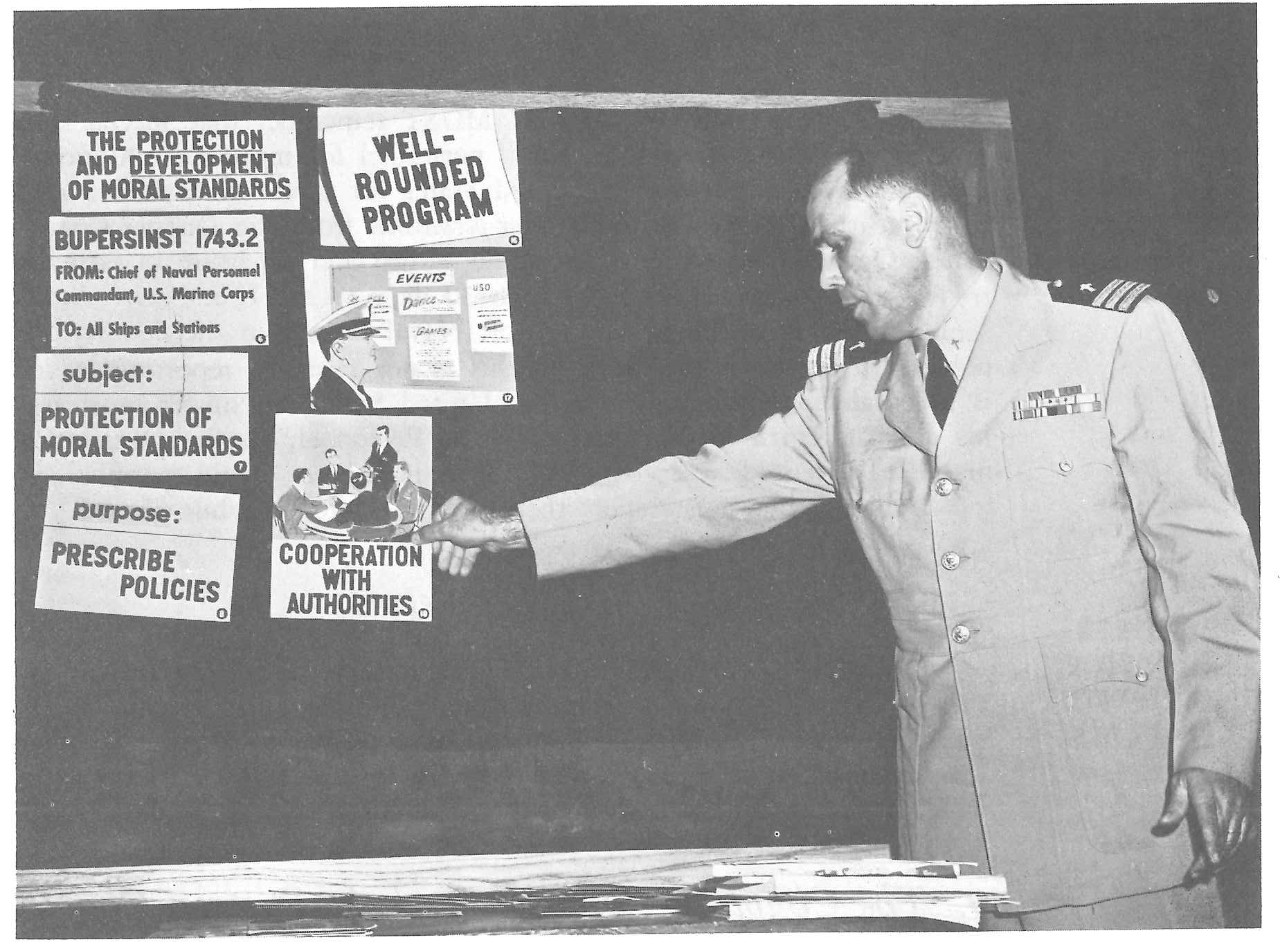
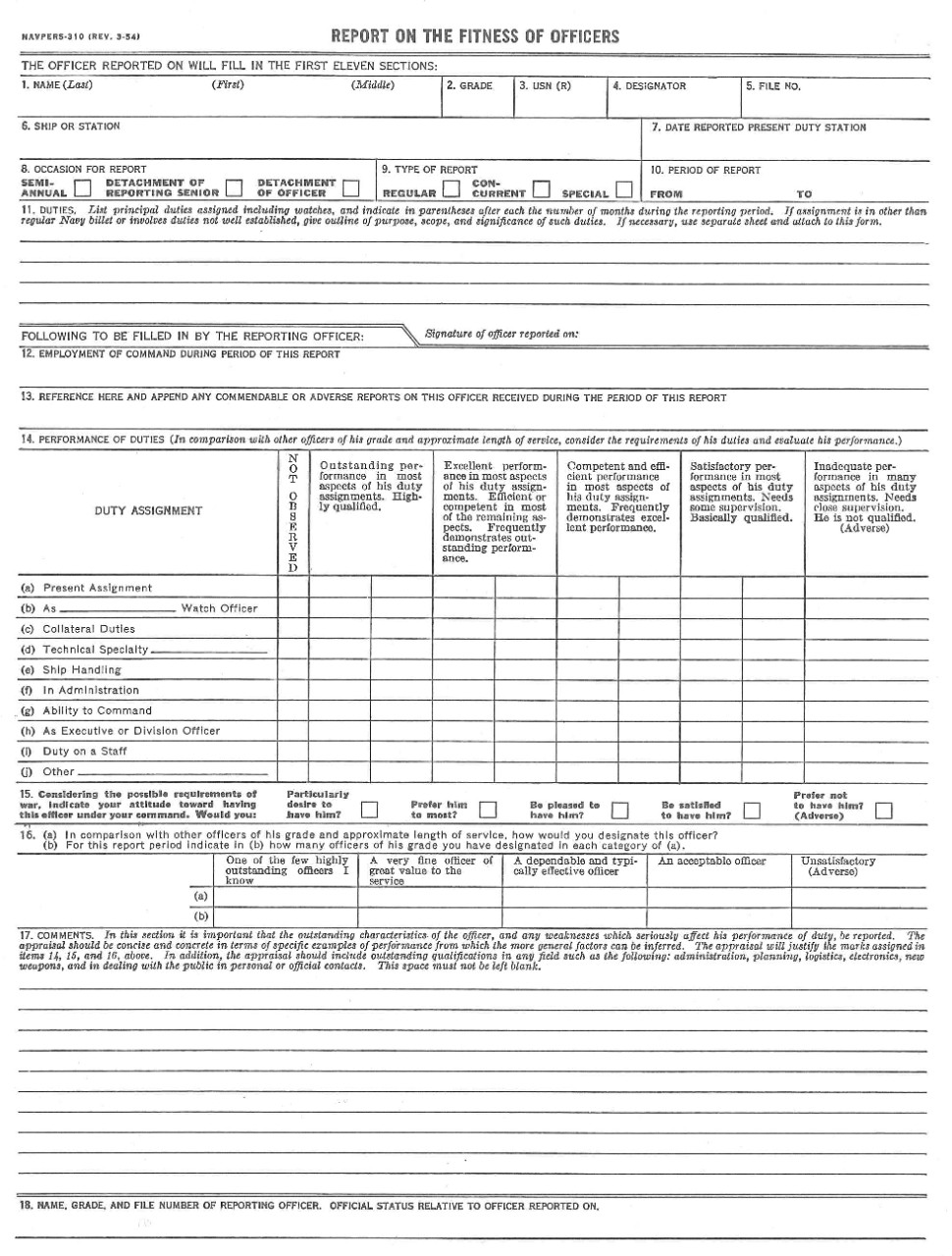
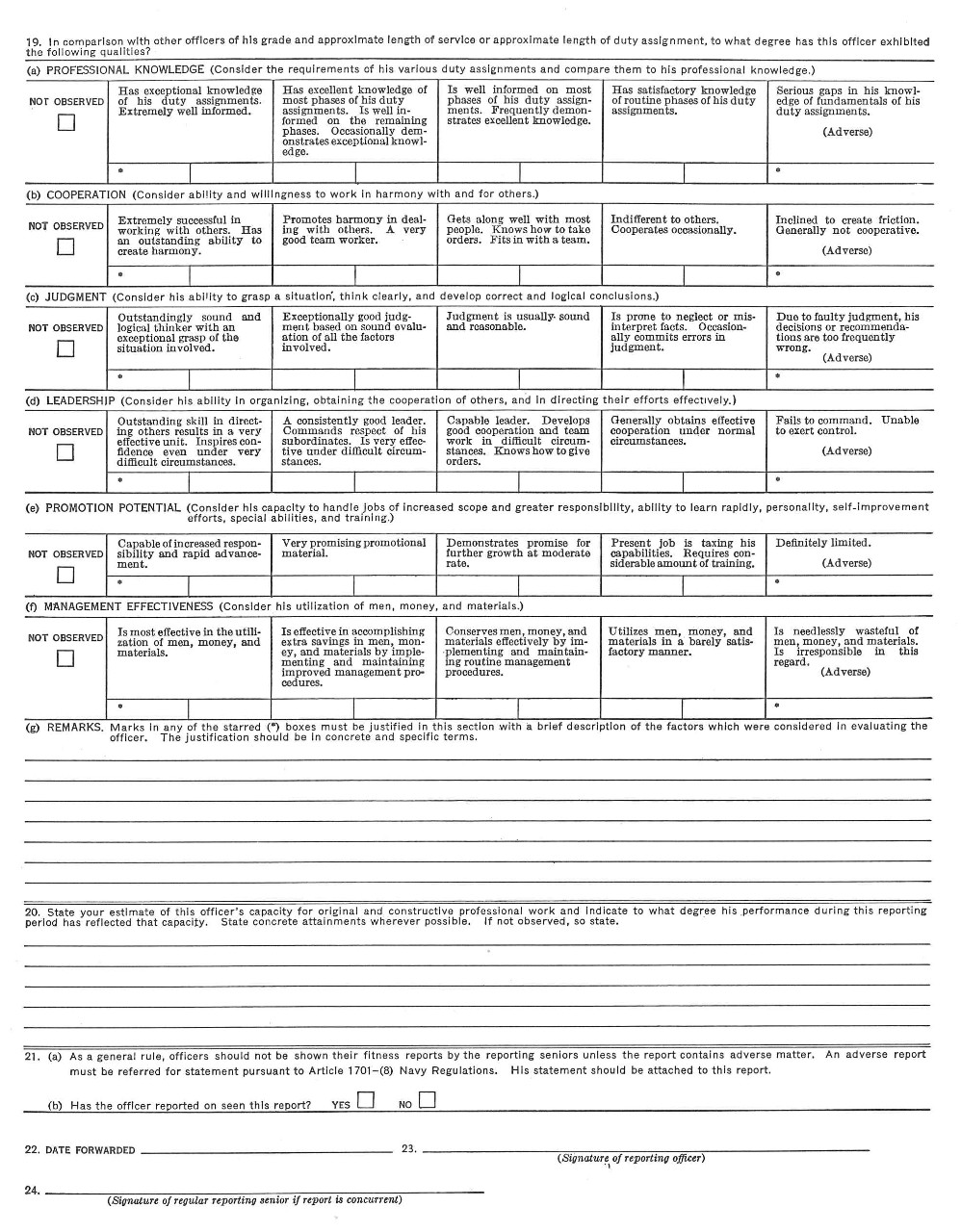
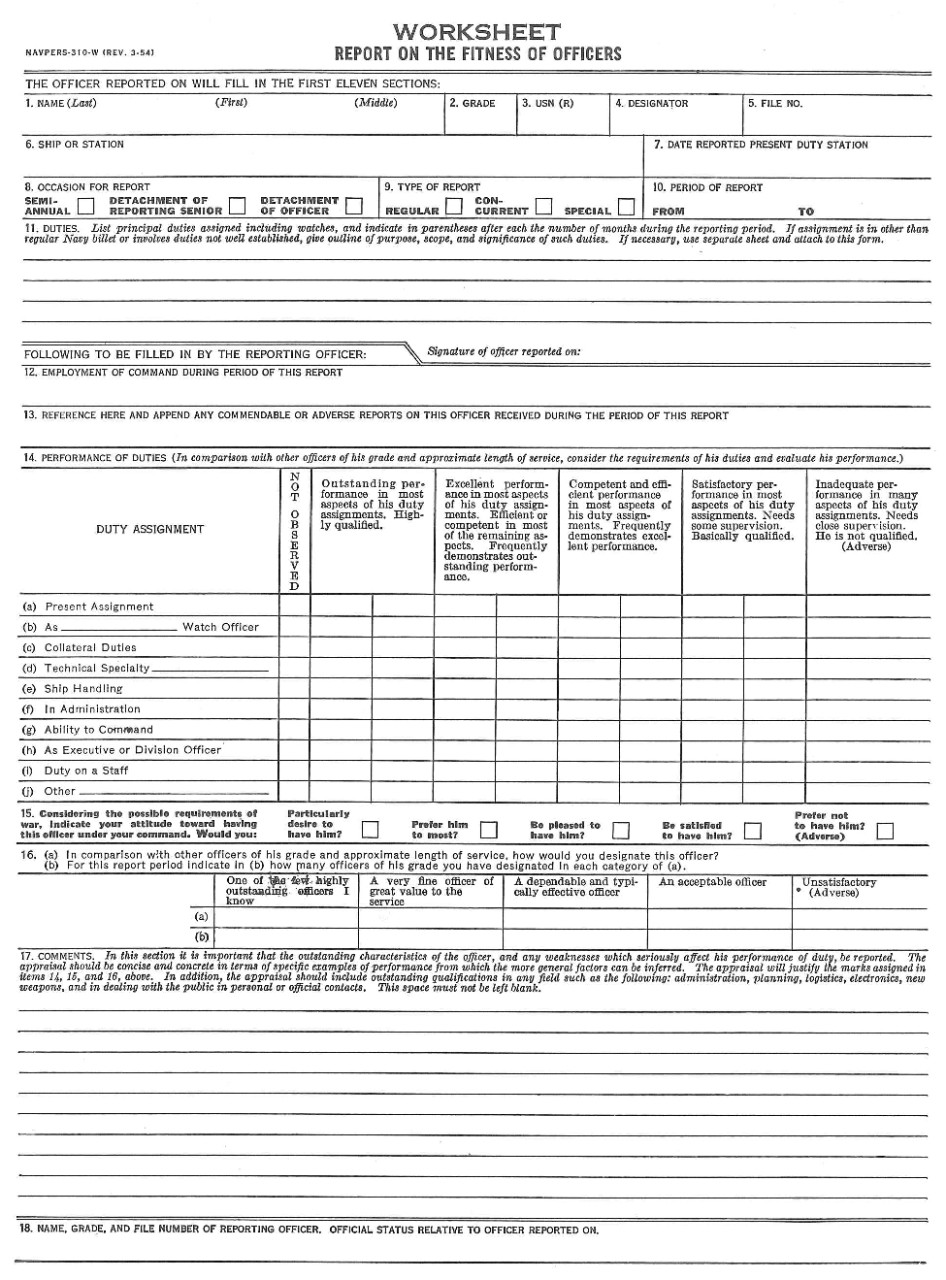
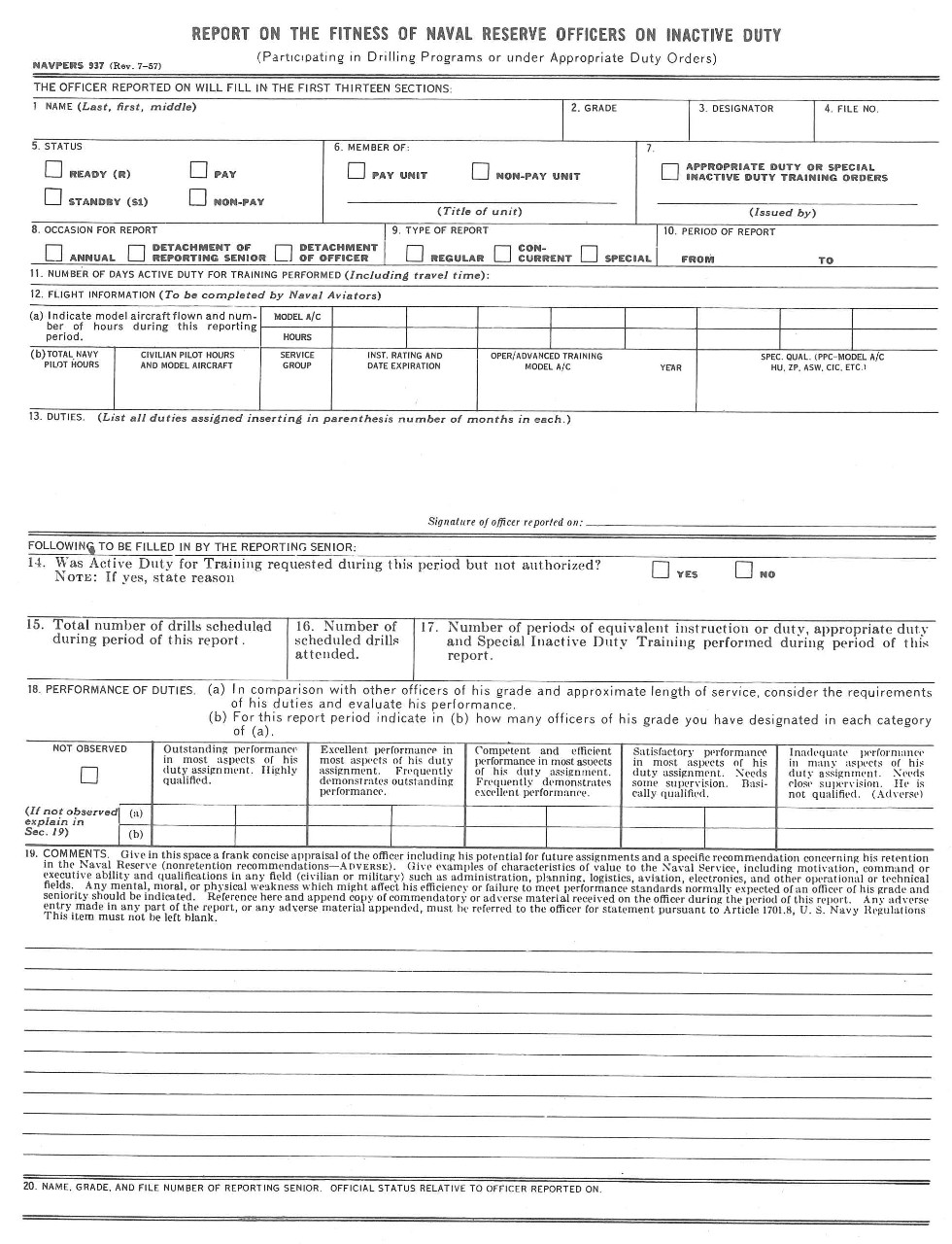
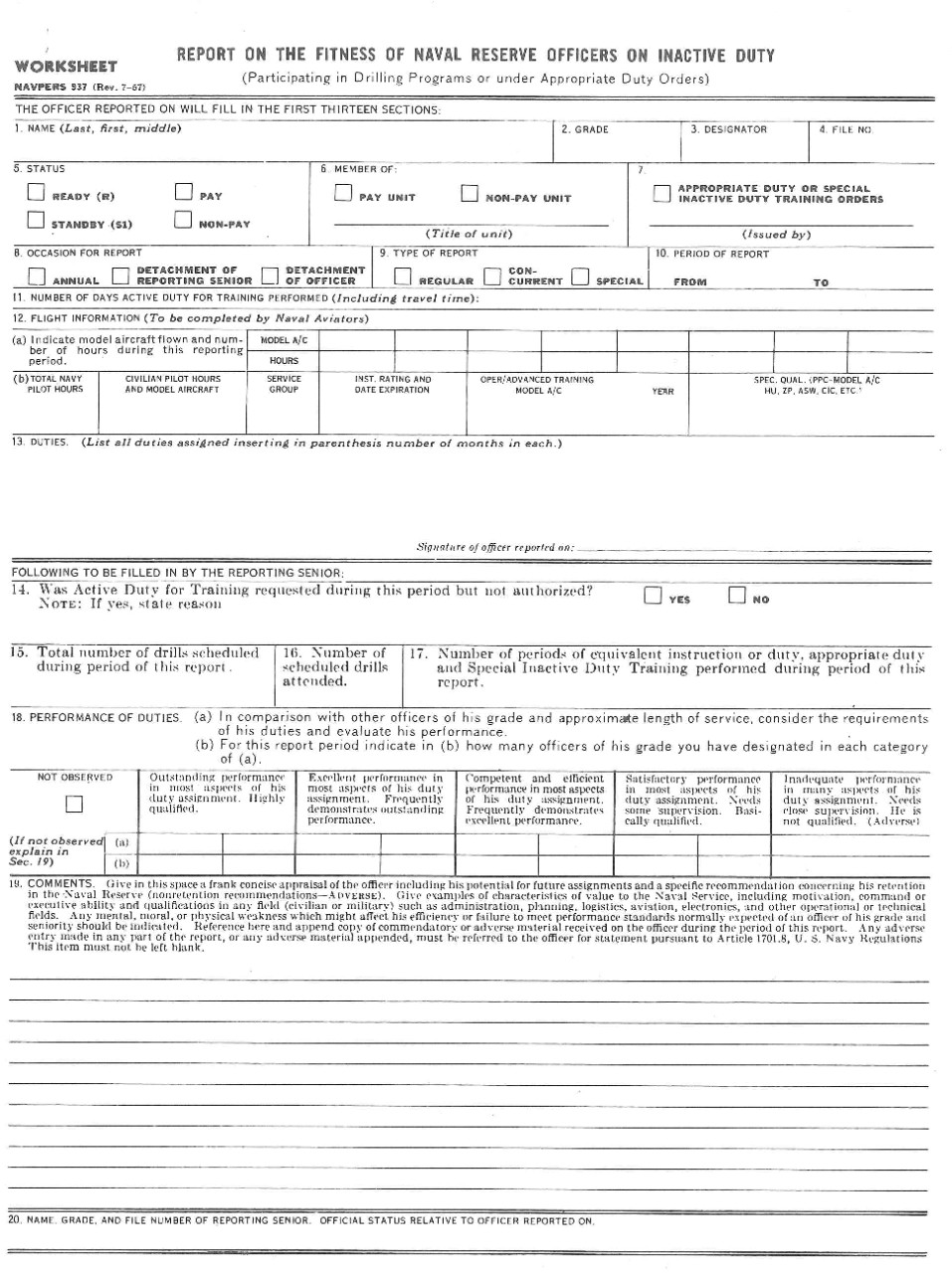
Appendix
The Naval Reserve Categories
ACTIVE STATUS
Ready Reserve (USNR-R): Those in this category are immediately available in any emergency proclaimed by the President. Only those in this classification may avail themselves of annual active duty for training with pay. They may also earn promotion and retirement credit points in the training program.
Reserves who are in a non-pay status taking training duty will be furnished transportation requests and subsistence allowances but are not entitled to travel by private conveyance.
Standby Reserve Active (USNR-S1): Those in this classification may be called only in time of war or a national emergency declared by Congress. They may participate in the training program. They may be associated with a non-pay unit or with a pay unit in non-pay status, or take active duty for training without base pay. They will, however, receive transportation at the expense of the government (TR) and furnished subsistence allowance. They may earn retirement and promotion credit points in the training program.
INACTIVE STATUS LIST
Standby Reserve-Inactive (USNR-S2): Those in this category are subject to recall only in time of war or national emergency declared by Congress. They are eligible, however, for voluntary non-creditable participation, subject to the approval of the unit Commanding Officer. Such officers may take correspondence courses for promotion credit only. They may not receive any retirement credit for any participation and are not eligible for consideration for promotion. They may not take training duty with or without pay.
An officer may be transferred to the Inactive Status List for the following reasons:
(1) At his own request, if eligible
(2) Lack of progress
(3) After twice being passed over in the rank held, and if he has been credited with twenty years of satisfactory service.
THE RETIRED RESERVE
Retired Reserve (USNR-RET): Those in this category are eligible for recall in time of war or in a national emergency declared by Congress.
60
REQUIREMENTS FOR TRANSFER TO THE RETIRED RESERVE
Members of the Naval Reserve upon application may be transferred to the Retired Reserve List within the discretion of the Secretary of the Navy. The eligibility requirements for such transfer are as follows:
(1) Has completed a total of twenty years of honorable service in any component of the Armed Forces or Armed Force without component.
(2) Has been found physically disqualified for active duty as a result of service-connected disability regardless of total years of service completed.
(3) Has completed ten or more years of active Federal commissioned service.
(4) Has been found physically disqualified for active duty, not as a result of his own misconduct, regardless of total years of service completed.
(5) Having attained the age of 37 years, may be transferred provided he:
a. Has completed a minimum of eight years of satisfactory Federal service subsequent to 1 July 1949.
b. Has completed a minimum of eight years of service provided that he has served honorably on active duty in time of war or national emergency for at least six months.
TRANSFER FO THE READY RESERVE
A reservist-retired may request “Ready” status if he can qualify as to age and physical qualifications.
THE READY RESERVE AGREEMENT
Reservists may transfer to the Ready Reserve from other categories by executing a valid agreement to remain in its membership for a stipulated period of time, for a minimum of one year and a maximum of five years provided they meet the following requirements;
(1) Physically qualified
(2) Not overage in grade
A valid agreement is any agreement executed to expire on an 1 April or 1 October, within a period of not less than one year nor more than five years from the date of submission.
Chaplains should make certain that their Ready Reserve agreements are current. Members of the Ready Reserve will normally be solicited for renewal of expiring agreements prior to the effective date of transfer.
Submission of a Ready Reserve Agreement, for further retention in the Ready Reserve, is required upon completion of any of the following:
(1) Five or more years active service in an armed force of the United States.
(2) A period of active duty as above which combined with a period of satisfactory participation in an accredited training program totals five years.
Satisfactory Participation in an accredited training program may be achieved in any of the following ways:
(1) All service prior to 1 July 1949.
(2) From 1 July 1949 to 1 January 1953, each full year of satisfactory Federal Service.
(3) Since 1 January 1953, attendance at the required number of drills plus fourteen days active-duty-for-training-both actions completed within four consecutive fiscal quarters:
61
a. If 24 drills, 100% participation is required
b. If 48 drills, 90% participation is required
(4) Twelve months active service during the statutory limits of World War II, plus twelve months active service during the Korean conflict.
(5) Eight years membership in any reserve component subsequent to 2 September 1945.
62



